Table of Contents
- Introduction
- Editor’s Choice
- Medical Imaging Market Statistics
- Medical Imaging Equipment Market Revenue Worldwide Statistics
- Medical Imaging Analytics Software Market Statistics
- Market Statistics By AI-enabled Medical Imaging Solutions
- Diagnostic Imaging Devices Market Overview
- Computed Tomography Market Overview
- Computed Tomography Examinations and Scanner Density
- Global Medical X-ray Market Size
- Magnetic Resonance Imaging (MRI) Examinations and MRI Units
- Medical Imaging Device Usage Statistics
- Medical Imaging Cost Statistics
- Waiting Time for Medical Scans
- Key Investments
- Regulations for Medical Imaging Devices
- Recent Developments
- Conclusion
- FAQs
Introduction
Medical Imaging Statistics: Medical imaging is essential for visualizing internal body structures to aid in diagnosis, monitoring, and treatment.
Key modalities include X-ray imaging, which highlights bones and some soft tissues; and computed tomography (CT).
Which provides cross-sectional images for detecting fractures and tumors; Teleradiology (MRI). It is known for its detailed soft tissue images; and ultrasound, widely used in obstetrics and cardiology.
Nuclear medicine employs radioactive materials to evaluate organ function, while positron emission tomography (PET) helps assess metabolic activity in cancer.
Recent advancements, such as hybrid imaging techniques and the integration of artificial intelligence. Further, enhances diagnostic accuracy and treatment efficacy, solidifying the role of medical imaging in modern healthcare.
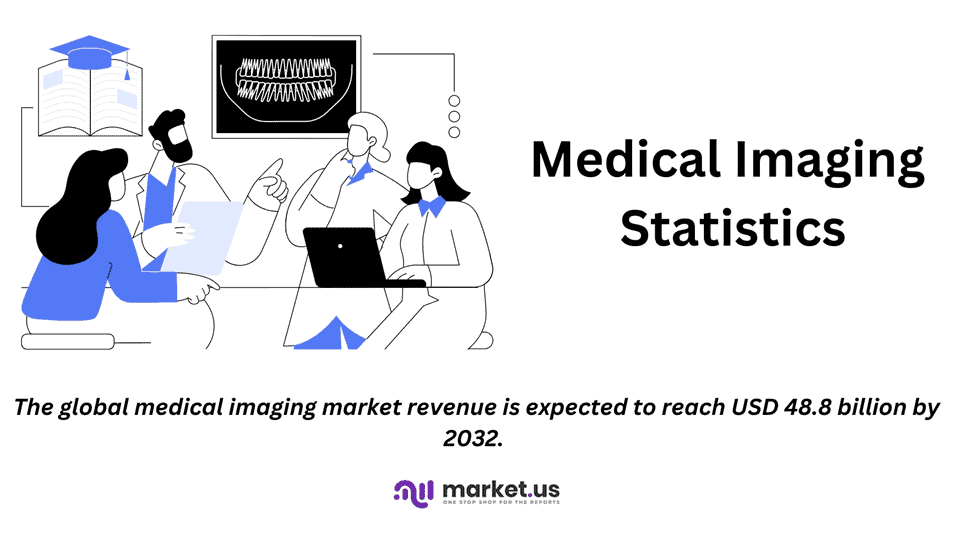
Editor’s Choice
- The global medical imaging market revenue is expected to reach USD 48.8 billion by 2032.
- The global medical imaging market is segmented by end-users. Reveals that hospitals represent the largest share, accounting for 49% of the total market.
- The global medical imaging equipment market revenue is forecasted to reach USD 48.58 billion by 2026.
- The global market for AI-enabled medical imaging solutions is expected to experience remarkable growth. Increasing from a valuation of USD 1.35 billion in 2021 to an anticipated USD 18.36 billion by 2032.
- The global diagnostic imaging devices market has experienced substantial growth since 2016. When its revenue was recorded at USD 38.49 billion, and it is projected to reach USD 59.25 billion by 2029.
- In the global diagnostic imaging market, the top ten companies have maintained relatively stable market shares between 2017 and 2024, with Siemens Healthineers holding the largest share. Slightly increasing from 23.2% in 2017 to 23.5% in 2024.
- In the United States, the Food and Drug Administration (FDA) classifies medical devices into three categories—Class I, II, and III—based on risk. With increasing levels of regulatory control for each class.
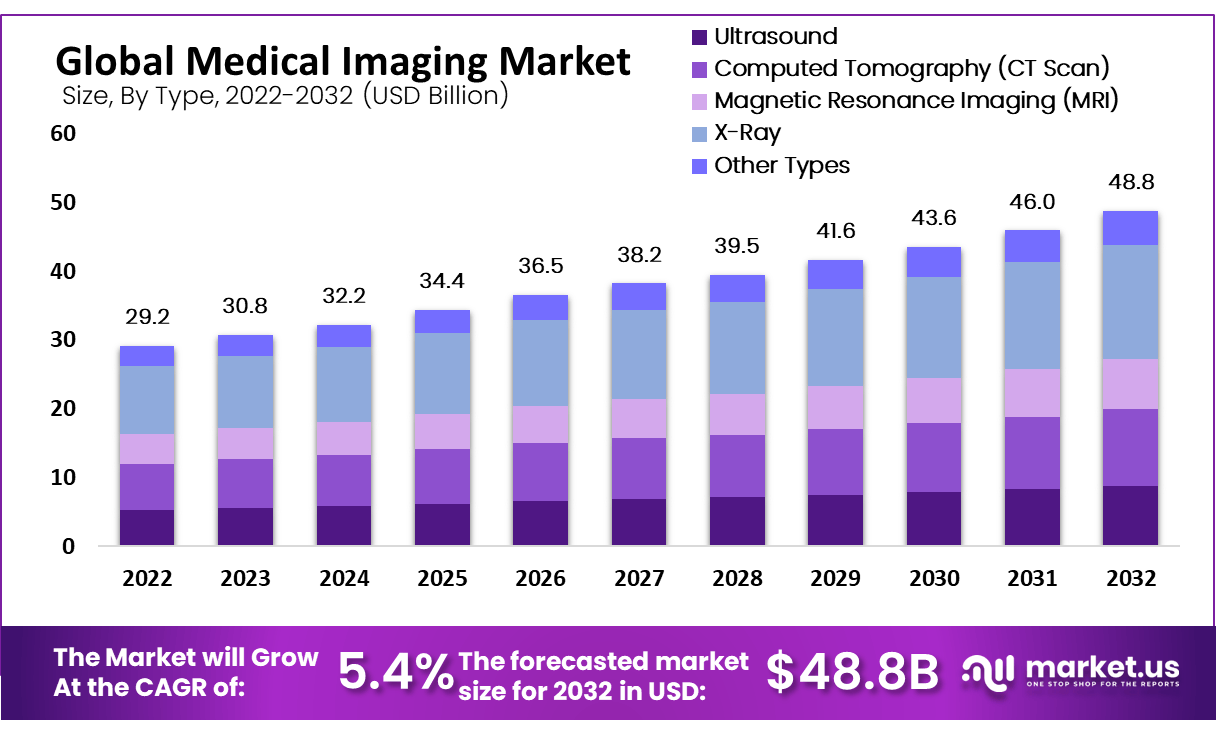
Medical Imaging Market Statistics
Global Medical Imaging Market Size Statistics
- The global medical imaging market has demonstrated steady growth at a CAGR of 5.40%. With market revenue expanding from USD 29.2 billion in 2022 to an estimated USD 48.8 billion by 2032.
- This trajectory indicates a consistent year-on-year increase, with revenue anticipated to reach USD 30.8 billion in 2023 and USD 32.2 billion in 2024.
- The market is projected to continue its upward trend. Achieving USD 34.4 billion by 2025 and USD 36.5 billion by 2026.
- By 2027, the revenue is expected to reach USD 38.2 billion. Followed by an increase to USD 39.5 billion in 2028.
- The growth rate remains substantial through the end of the decade, with the market estimated to achieve USD 41.6 billion by 2029 and USD 43.6 billion by 2030.
- By 2031, the market size is projected at USD 46.0 billion, culminating in USD 48.8 billion by 2032.
- This sustained growth underscores the increasing demand for advanced imaging technologies and the rising focus on healthcare innovations across global markets.
(Source: market.us)
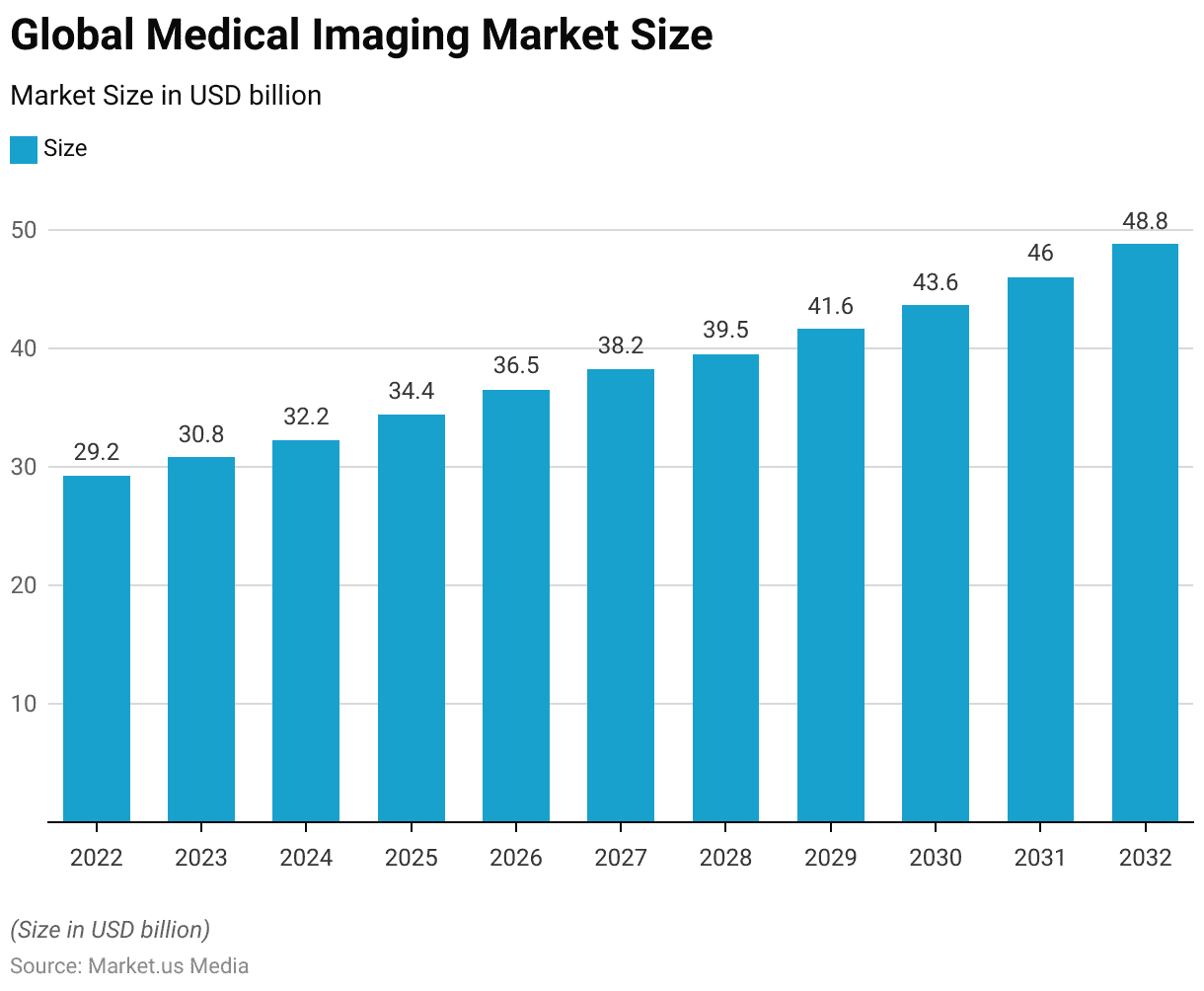
Medical Imaging Market Size – By Type Statistics
- The global medical imaging market, segmented by type, has shown a steady increase in market size. Advancing from USD 29.2 billion in 2022 to an estimated USD 48.8 billion by 2032.
- Among the various imaging modalities, ultrasound technology rose from USD 5.26 billion in 2022 to a projected USD 8.78 billion by 2032.
- Computed Tomography (CT) also observed growth. Starting at USD 6.72 billion in 2022 and expected to reach USD 11.22 billion by 2032.
- Magnetic Resonance Imaging (MRI) showed a similar expansion, with market size moving from USD 4.38 billion in 2022 to a forecasted USD 7.32 billion by 2032.
- The X-Ray segment is consistently the largest among the imaging types. Grew from USD 9.93 billion in 2022 and is anticipated to hit USD 16.59 billion by 2032.
- Other imaging types also contributed to this growth, with market size increasing from USD 2.92 billion in 2022 to USD 4.88 billion by 2032.
- This steady upward trend across all segments reflects the ongoing advancements in imaging technology and the heightened demand for diagnostic tools across global healthcare sectors.
- The continuous growth in each category signifies the industry’s adaptability and commitment to meeting the rising need for precise and efficient diagnostic solutions.
(Source: market.us)
Take advantage of our unbeatable offer - buy now!


Global Medical Imaging Market Share – By End-user Statistics
- The global medical imaging market is segmented by end-users. Reveals that hospitals represent the largest share, accounting for 49% of the total market.
- Diagnostic imaging centers follow, comprising 28% of the market, driven by the increasing demand for specialized diagnostic services.
- Specialty clinics make up 13% of the market share, reflecting a steady demand for imaging services within focused healthcare settings.
- The remaining 10% of the market is attributed to other end-users. Which include a variety of medical facilities and institutions utilizing imaging technology.
- This distribution indicates the central role hospitals play in the adoption and utilization of medical imaging technologies. Followed by diagnostic imaging centers as key contributors to the market’s growth and demand.
(Source: market.us)
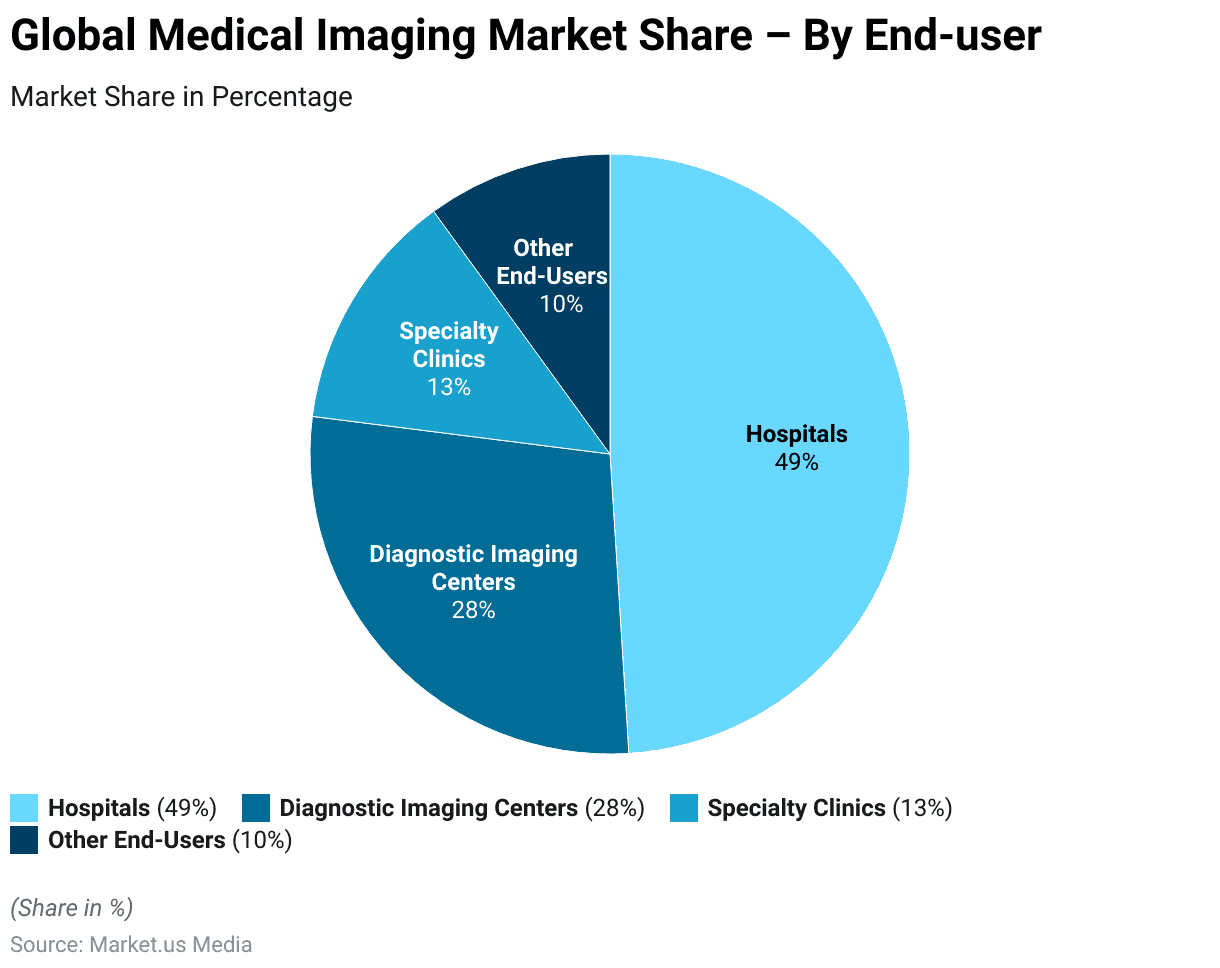
Medical Imaging Equipment Market Revenue Worldwide Statistics
- The global medical imaging equipment market has shown a pattern of growth from 2017 through to the projected figures for 2026.
- Beginning at USD 36.79 billion in 2017, the market saw a steady increase to USD 38.08 billion in 2018 and USD 39.09 billion in 2019.
- However, in 2020, there was a slight decline, with the market value dropping to USD 36.44 billion, likely due to disruptions caused by global events.
- Recovery followed in 2021, with the market value increasing to USD 38.36 billion, and this growth continued into 2022, reaching USD 40.43 billion.
- The market is projected to expand further in the following years. Reaching an estimated USD 42.61 billion in 2023 and USD 44.92 billion in 2024.
- Notably, the market is expected to maintain this value in 2025 before experiencing another significant rise in 2026. Where it is forecasted to achieve USD 48.58 billion.
- This upward trajectory underscores the increasing demand for medical imaging equipment globally, driven by advancements in technology. Rising healthcare expenditures, and an expanding focus on diagnostic accuracy in healthcare systems.
(Source: Statista)
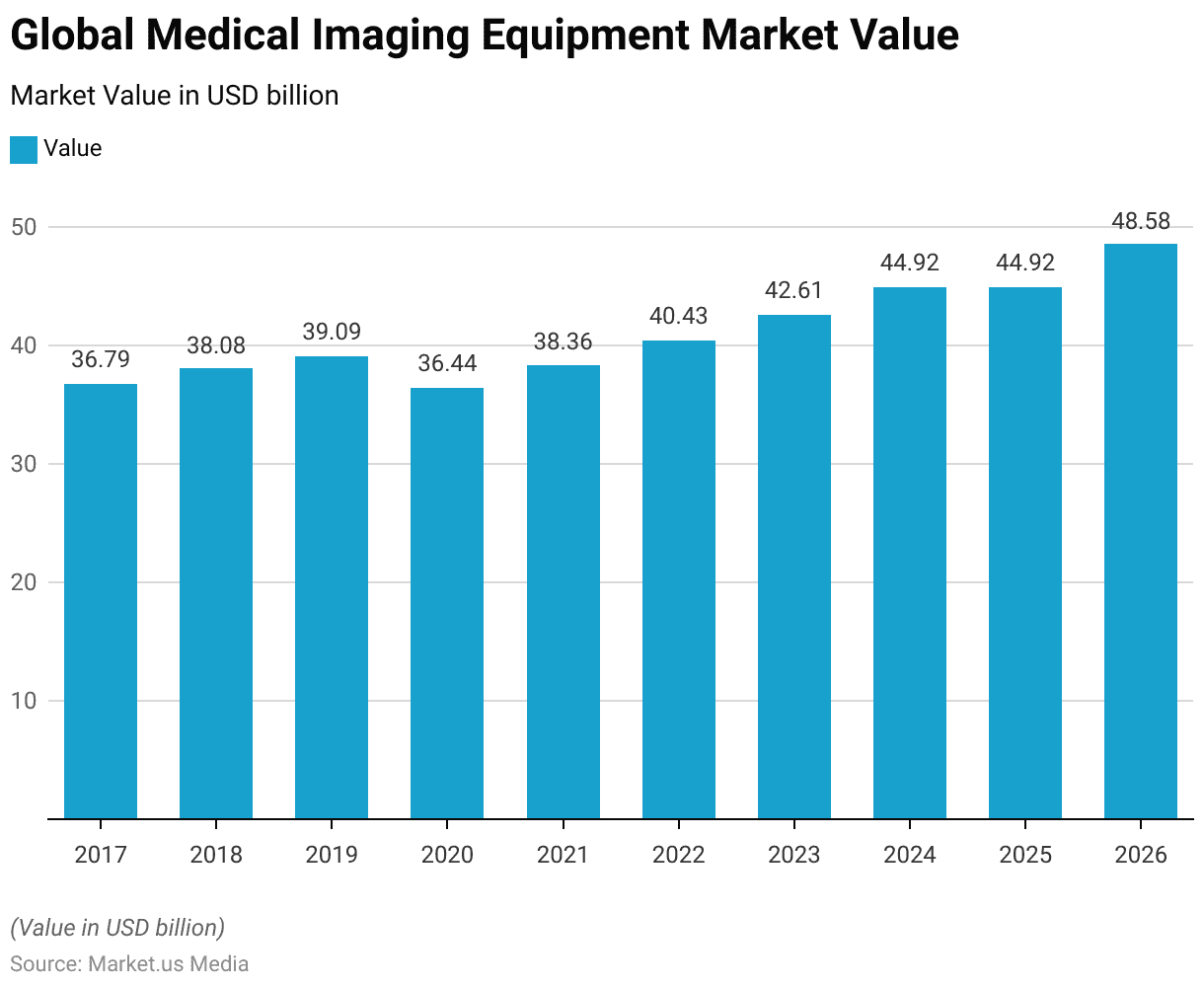
Medical Imaging Analytics Software Market Statistics
Global Medical Imaging Analytics Software Market Size Statistics
- The global medical imaging analytics software market has shown significant growth, with its market size increasing from USD 2.43 billion in 2016 to an anticipated USD 4.26 billion by 2025.
- This growth reflects a rising demand for advanced software solutions in medical imaging, driven by the need for precise analysis. Improved diagnostic capabilities, and enhanced data processing in healthcare.
- Further, the expansion is indicative of the increasing reliance on analytics software to support clinical decision-making and improve patient outcomes as healthcare providers continue to adopt innovative technologies to meet the growing requirements of modern diagnostics.
(Source: Statista)

Medical Imaging Analytics Software Market Share – By Imaging Modality Statistics
- The global medical imaging analytics software market has exhibited changes in its distribution by imaging modality from 2016 to the projected figures in 2025.
- Ultrasound retained the largest market share. However, it is expected to decrease slightly from 31% in 2016 to 29% by 2025.
- Radiographic (X-ray) imaging also saw a minor reduction. Moving from an 18% share in 2016 to a projected 16% in 2025.
- In contrast, Computed Tomography (CT) and Magnetic Resonance Imaging (MRI) modalities experienced growth. CT’s market share is expected to rise from 15% in 2016 to 16% in 2025. While MRI is projected to increase from 12% to 14%.
- Combined modality imaging is anticipated to grow slightly from 9% in 2016 to 10% by 2025. Reflecting the growing demand for integrated diagnostic solutions.
- Mammography’s share also increased, moving from 8% in 2016 to an expected 9% in 2025.
- Other imaging modalities collectively decreased from 7% to 6% over the same period.
- These trends highlight an increasing adoption of advanced imaging techniques, particularly CT and MRI, within the analytics software market. Driven by the evolving need for comprehensive diagnostic insights in healthcare.
(Source: Statista)

Global Medical Imaging Analytics Software Market Size – By Region Statistics
- The global medical imaging analytics software market is segmented by region. Exhibited significant growth from 2016 to the projected figures for 2025.
- North America led the market, with its value increasing from USD 780.8 million in 2016 to an anticipated USD 1,310.8 million by 2025.
- Europe followed closely, growing from USD 743.6 million to a forecasted USD 1,215.1 million over the same period.
- The Asia-Pacific region demonstrated substantial expansion as well, with its market size expected to rise from USD 614 million in 2016 to USD 1,146.1 million by 2025. Reflecting the growing adoption of advanced medical imaging solutions in this region.
- The rest of the world, although a smaller segment, also saw notable growth, with its market size increasing from USD 125.5 million in 2016 to an estimated USD 264.7 million by 2025.
- This consistent growth across regions underscores the expanding demand for medical imaging analytics software globally. Driven by advancements in healthcare technology and an increasing emphasis on precision diagnostics across both developed and emerging markets.
(Source: Statista)

Market Statistics By AI-enabled Medical Imaging Solutions
AI-enabled Medical Imaging Solutions Market Value Worldwide Statistics
- The global market for AI-enabled medical imaging solutions is expected to experience remarkable growth. Increasing from a valuation of USD 1.35 billion in 2021 to an anticipated USD 18.36 billion by 2032.
- This substantial expansion reflects the increasing adoption of artificial intelligence in healthcare. Driven by the technology’s potential to enhance diagnostic accuracy, streamline workflow, and improve patient outcomes.
- Further, the projected growth underscores the transformative role AI is expected to play in the medical imaging sector as healthcare providers seek innovative solutions to meet the rising demand for efficient and precise diagnostic tools worldwide.
(Source: Statista)

Modality By AI-enabled Medical Imaging Solutions Market Worldwide Statistics
- The distribution of the AI-enabled medical imaging solutions market by modality is anticipated to show subtle shifts between 2021 and 2032.
- Computed Tomography (CT) held the largest share in 2021. Accounting for 44.02% of the market, with a slight decrease projected to 42% by 2032.
- Magnetic Resonance (MR) imaging followed, with a 25.28% share in 2021. Expected to decline marginally to 24.8% by 2032.
- Ultrasound, representing 11.29% of the market in 2021, is anticipated to experience a minor increase, reaching 11.7% by 2032.
- X-ray imaging’s share is expected to decrease from 7.05% in 2021 to 6.8% by 2032. Mammography is projected to grow slightly from 5.57% to 6.2% over the same period.
- Multimodality imaging systems, which accounted for 2.82% in 2021, are expected to see more notable growth, increasing to 4.2% by 2032. Reflecting the rising demand for integrated imaging solutions.
- Other modalities collectively are projected to grow from 3.96% to 4.3%.
- These shifts underscore a gradual diversification in the AI-enabled imaging market, with a growing emphasis on multimodal and advanced diagnostic solutions as the field evolves.
(Source: Statista)
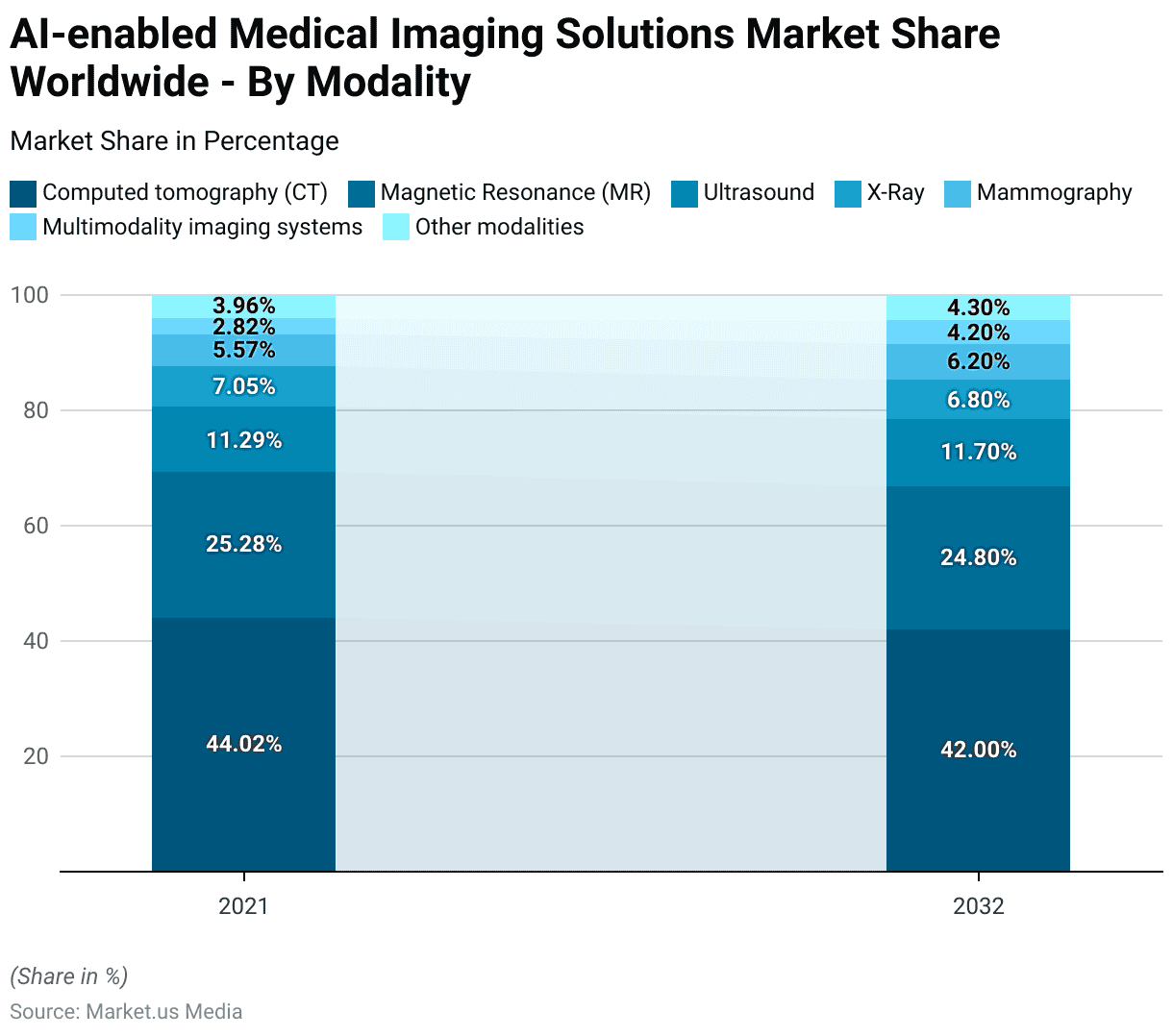
AI-enabled Medical Imaging Solutions Market Worldwide – By Deployment Model Statistics
- The AI-enabled medical imaging solutions market is segmented by deployment model. This has shown a preference for cloud and web-based solutions, which accounted for 64.72% of the market in 2019.
- This trend is expected to continue, with cloud-based deployment projected to increase slightly, reaching 66.25% by 2030.
- In contrast, on-premise solutions, which held a 35.28% share in 2019, are forecasted to decline to 33.75% by 2030.
- This shift highlights the growing adoption of cloud technology in medical imaging. Driven by its scalability, accessibility, and potential to support advanced AI functionalities.
- The trend reflects a broader movement in healthcare towards cloud solutions that enable enhanced data sharing and remote access. Catering to the evolving needs of modern diagnostic environments.
(Source: Statista)
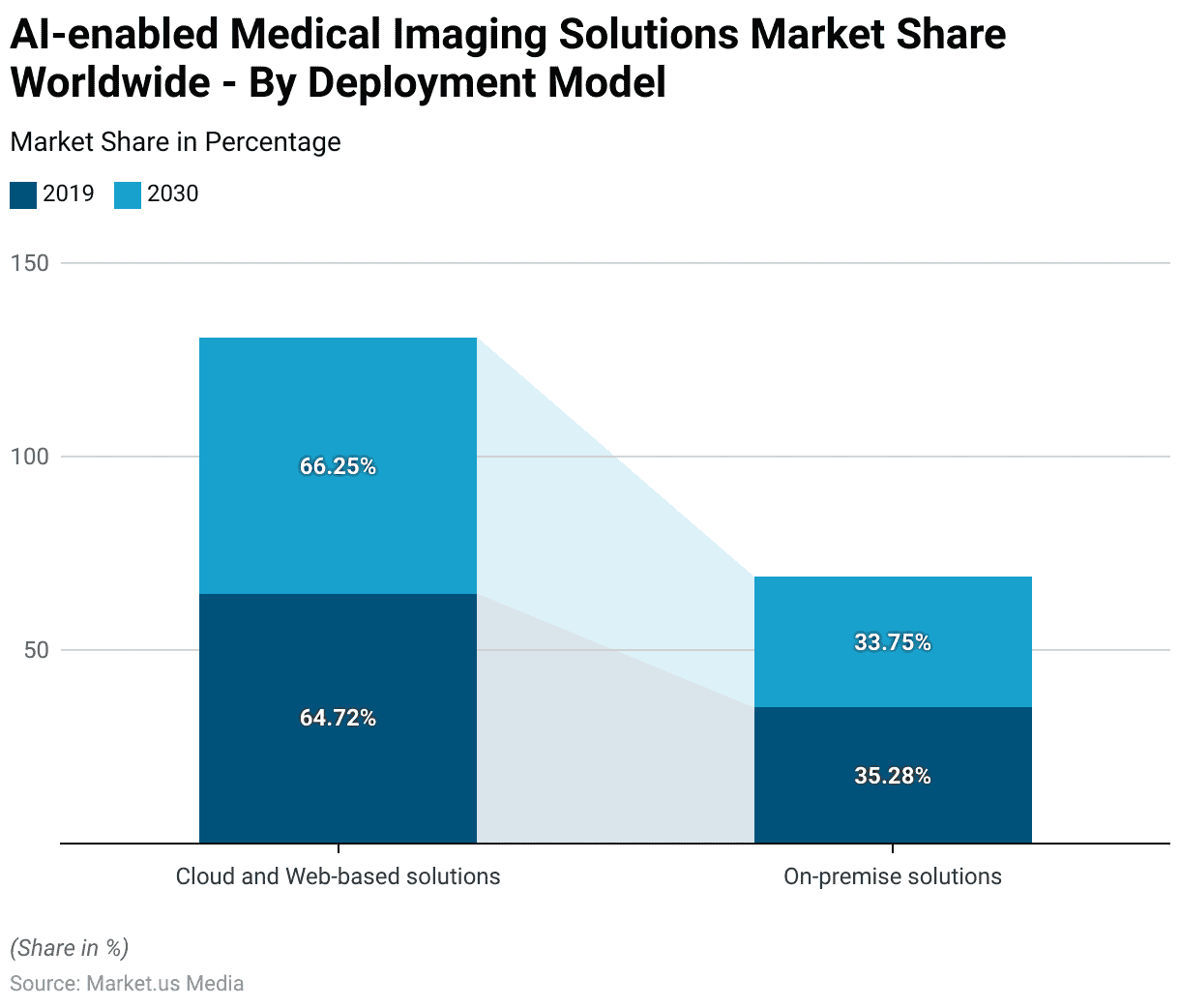
Diagnostic Imaging Devices Market Overview
Global Medical Diagnostic Imaging Devices Market Size Statistics
- The global diagnostic imaging devices market has experienced substantial growth since 2016 when its revenue was recorded at USD 38.49 billion, and it is projected to reach USD 59.25 billion by 2029.
- This growth trend reflects a steady increase in demand for diagnostic imaging technologies despite a temporary decline in 2020 to USD 39.69 billion, likely influenced by global disruptions.
- Following this dip, the market rebounded, reaching USD 42.44 billion in 2021 and USD 43.51 billion in 2022.
- The upward trend continued, with the market estimated at USD 45.53 billion in 2023 and projected to reach USD 47.65 billion in 2024.
- Looking forward, revenue growth is expected to accelerate, with the market anticipated to reach USD 49.97 billion in 2025 and surpass USD 52 billion by 2026.
- By 2027, the market is projected to attain USD 54.62 billion, followed by USD 56.92 billion in 2028.
- The forecast for 2029 suggests a market size of USD 59.25 billion. Reflecting sustained demand for diagnostic imaging devices across global healthcare systems.
- This consistent expansion highlights the essential role of imaging technologies in modern healthcare. Driven by advancements in medical diagnostics and increasing healthcare needs worldwide.
(Source: Statista)
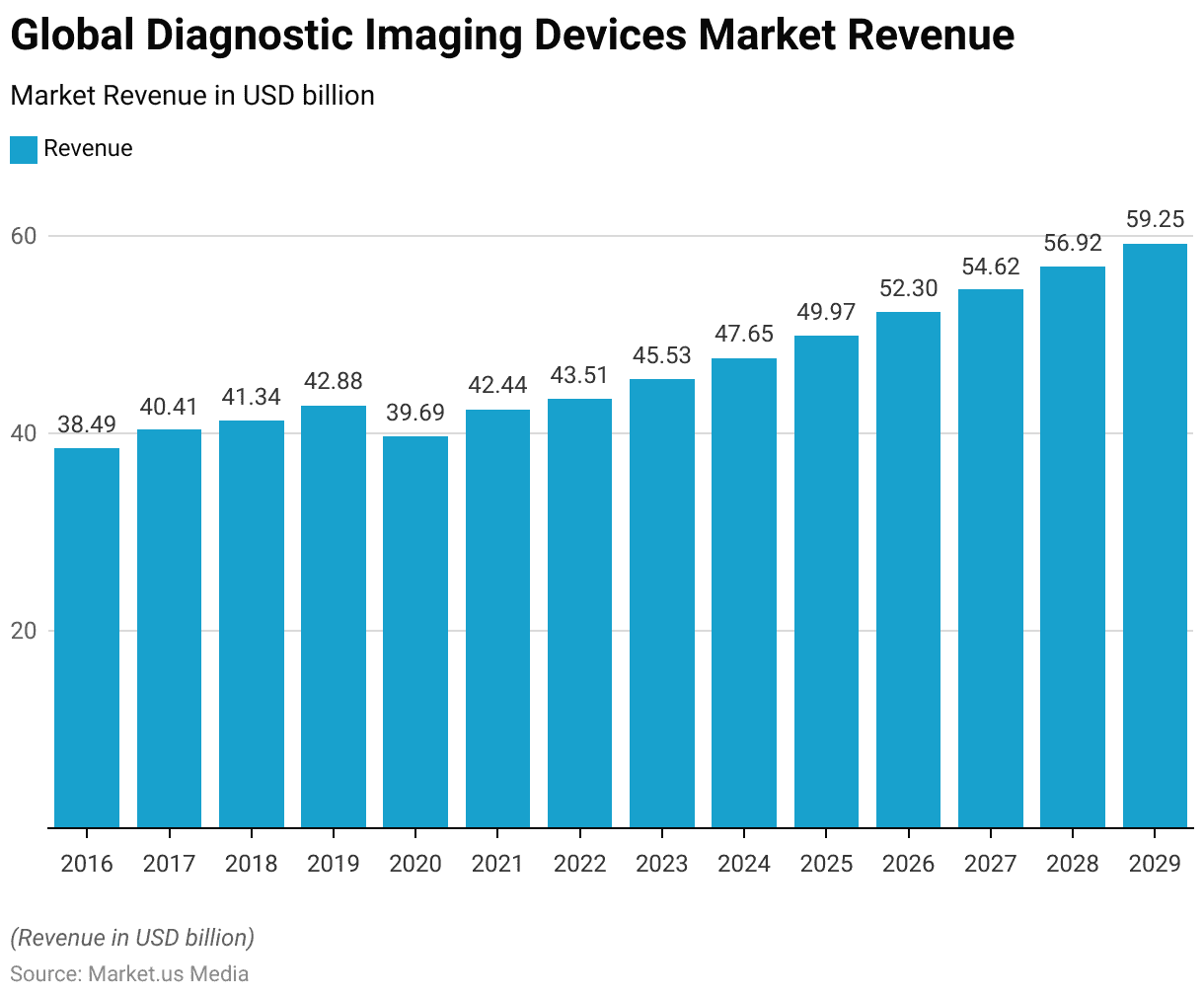
Global Medical Diagnostic Imaging Market Shares of Top Medtech Companies Statistics
- In the global diagnostic imaging market, the top ten companies have maintained relatively stable market shares between 2017 and 2024, with Siemens Healthineers holding the largest share, slightly increasing from 23.2% in 2017 to 23.5% in 2024.
- General Electric followed closely, with a slight decrease from 22.2% in 2017 to 21.6% in 2024.
- Philips saw an increase in its market share, rising from 19.7% in 2017 to 21.2% by 2024.
- Canon experienced a decrease in market share, moving from 9.8% in 2017 to 8.7% in 2024.
- Fujifilm Holdings maintained a stable position at 5.5% across both years. While Carestream Health and Hitachi retained market shares of 3% in 2017, with Hitachi experiencing a slight decline to 2.7% in 2024.
- Konica Minolta also saw a decrease in its share from 2.2% to 1.8% over this period.
- Varex Imaging and Hologic held smaller portions of the market, with Varex increasing marginally from 1.4% in 2017 to 1.5% in 2024 and Hologic experiencing a slight decrease from 1.5% to 1.4%.
- This data reflects the competitive stability within the market, with the top players consistently dominating the industry through incremental adjustments in their market shares.
(Source: Statista)
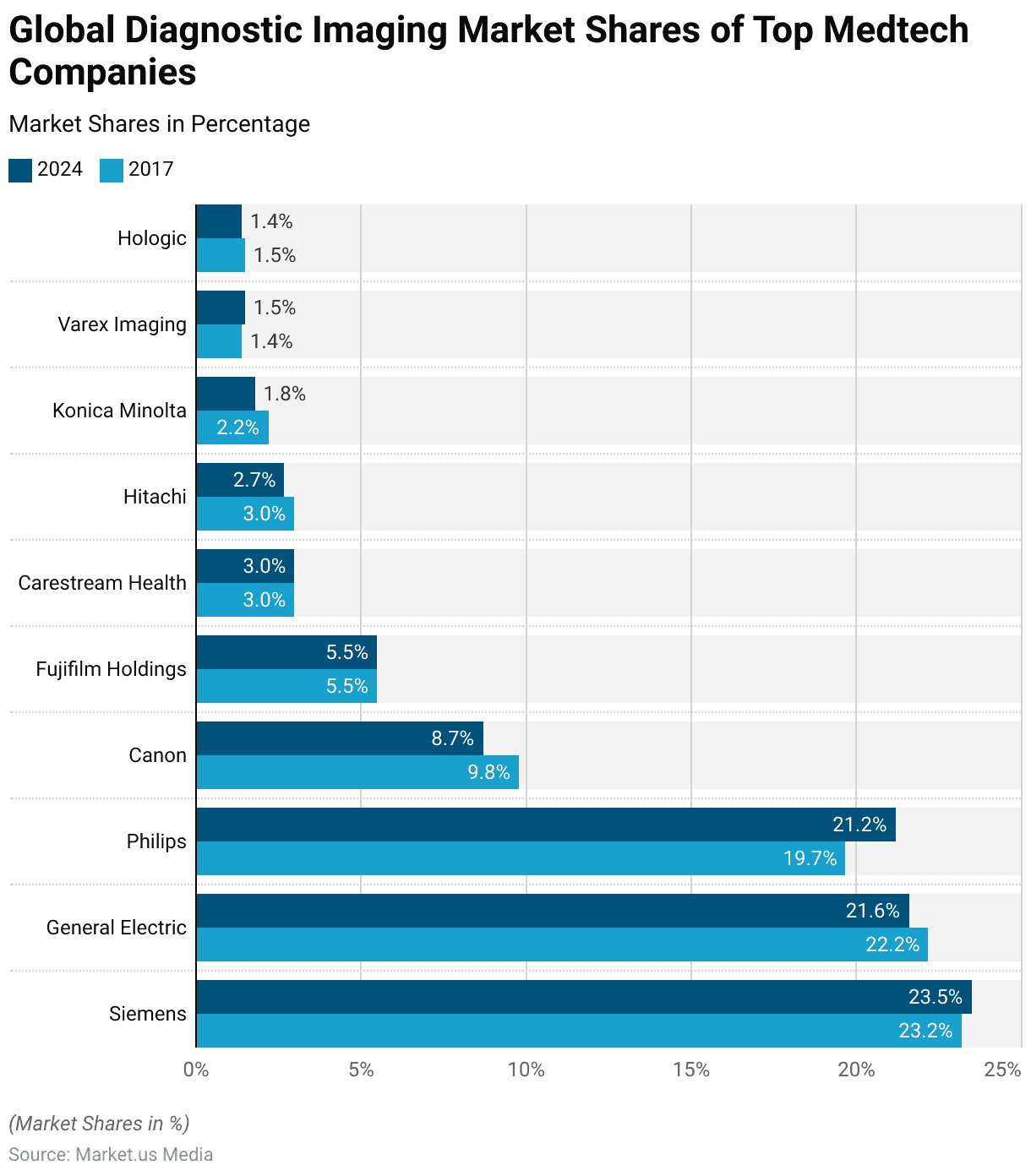
Computed Tomography Market Overview
Global Computed Tomography Market Size
- The global computed tomography (CT) market is projected to exhibit steady growth from 2023 to 2033.
- In 2023, the market is estimated to be valued at USD 4.4 billion, with a gradual increase to USD 4.7 billion in 2024 and USD 5.0 billion by 2025.
- This upward trend is expected to continue over the following years. Reaching USD 5.4 billion in 2026 and USD 5.8 billion by 2027.
- By 2028, the CT market is anticipated to grow to USD 6.2 billion, followed by USD 6.7 billion in 2029.
- The market’s expansion is projected to accelerate in the subsequent years, with an estimated value of USD 7.2 billion by 2030, USD 7.8 billion by 2031, and USD 8.4 billion by 2032.
- By 2033, the global CT market is expected to reach USD 9.1 billion.
- This consistent growth underscores the increasing demand for CT imaging technology. Driven by advancements in diagnostic capabilities and the heightened need for precise imaging in healthcare globally.
(Source: market.us)

Spine X-ray and CT Market Value – By Region
- The global market for spine X-ray and computed tomography (CT) is projected to experience considerable growth across all regions from 2020 to 2030.
- In North America, the market was valued at USD 288.5 million in 2020 and is forecasted to increase significantly to USD 495.6 million by 2030.
- Europe is expected to see similar growth, with its market value rising from USD 239.6 million in 2020 to USD 402 million in 2030.
- The Asia-Pacific region, which had the largest market share in 2020 at USD 303.7 million. This is projected to see the most substantial increase, reaching USD 569.7 million by 2030.
- The Rest of the World, while a smaller segment, is also expected to grow, with market value anticipated to rise from USD 84.1 million in 2020 to USD 156.2 million by 2030.
- This upward trend across regions highlights the increasing demand for spine imaging solutions globally. Driven by advancements in medical imaging technology. A rising incidence of spinal conditions, and growing healthcare investments.
(Source: Statista)

Computed Tomography Examinations and Scanner Density
Number of Examinations with Computer Tomography (CT) – By Country
- As of 2021, the frequency of computed tomography (CT) examinations per 1,000 inhabitants varied widely across selected countries.
- Korea reported the highest rate, with 281.5 CT scans per 1,000 inhabitants. Followed by the United States with 254.6 and Luxembourg with 243.6.
- Other countries with notably high examination rates included Belgium (223.3), France (217.8), Latvia (217.8), and Iceland (215.4).
- Denmark and Hungary also recorded substantial rates at 206.2 and 204.4, respectively, with Austria following closely at 199.1.
- In the mid-range, Slovakia reported 167.1 examinations per 1,000 inhabitants, while Australia had a rate of 164.
- Germany, Israel, and Greece exhibited rates of 159.8, 156.8, and 150.4, respectively.
- Other countries with moderate examination rates included Lithuania (148.7), Canada (144.1), Estonia (143.8), and Spain (133.8).
- The Netherlands and Czechia recorded 133.5 and 119.9 examinations per 1,000 inhabitants, respectively.
- At the lower end of the scale, Chile and Poland conducted 118.4 and 116.5 examinations per 1,000 inhabitants.
- Italy and Slovenia reported rates of 101.9 and 99.9, respectively. Finland had the lowest rate among the selected countries, with 44.7 CT examinations per 1,000 inhabitants.
- This data illustrates the varying levels of CT utilization across different healthcare systems. Influenced by factors such as healthcare infrastructure, access to diagnostic technology, and clinical practices.
(Source: Statista)
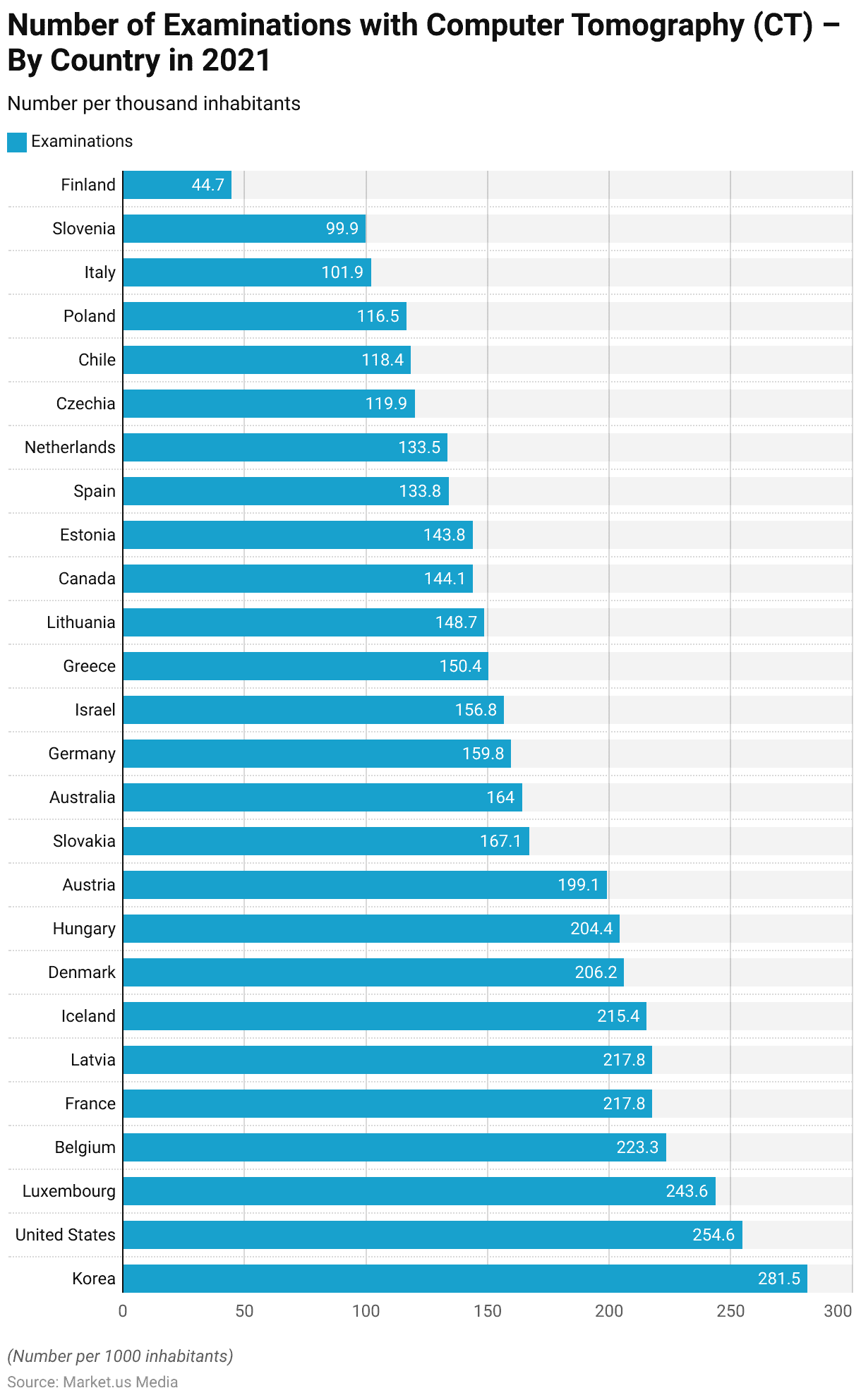
Computer Tomography Scanner Density – By Country
- As of 2021, the availability of computed tomography (CT) scanners per million population varied significantly across selected countries, with Japan leading by a substantial margin at 115.7 scanners per million people.
- Australia followed with 69.57 scanners, and Greece ranked third with 48.66 scanners per million.
- Other countries with relatively high densities of CT scanners included Iceland (46.39), Denmark (43.59), and the United States (42.63).
- New Zealand and South Korea reported similar figures at 42.35 and 42.19 scanners per million, respectively, with Switzerland and Italy at 39.06 and 38.73 scanners.
- In the mid-range, Latvia had 37.68 scanners per million, followed by Germany with 36.49 and Austria with 28.47.
- Belgium and Luxembourg showed lower scanner densities, with 25.65 and 23.24 scanners per million, respectively.
- Eastern European countries such as Poland, Spain, and Estonia reported densities between 21.04 and 22.04 scanners per million. While Ireland and Slovakia had 20.16 and 19.83, respectively.
- France and Slovenia had slightly fewer scanners, with 19.52 and 18.51 per million. While Finland, Czechia, and the Netherlands ranged between 15.86 and 16.96 scanners per million.
- Lower densities were observed in Turkey (15.1), Canada (14.6), and Russia (13.87).
- Hungary, Israel, and Mexico had the fewest scanners among the selected countries, with densities of 10.3, 9.62, and 7.47 scanners per million population, respectively.
- This distribution highlights variations in healthcare infrastructure, investment, and accessibility to advanced diagnostic technologies across regions.
(Source: Statista)

Global Medical X-ray Market Size
- The global medical X-ray market was valued at USD 11.2 billion in 2018 and is projected to grow significantly, reaching an estimated USD 16.5 billion by 2025.
- This growth reflects a rising demand for advanced diagnostic imaging technologies. Driven by the increasing prevalence of chronic diseases, advancements in healthcare infrastructure, and a heightened focus on early diagnosis.
- The market’s expansion is indicative of the growing importance of X-ray technology within medical imaging. Healthcare providers worldwide continue to adopt improved diagnostic tools to enhance patient care and outcomes.
(Source: Statista)

Magnetic Resonance Imaging (MRI) Examinations and MRI Units
Number of Examinations with Magnetic Resonance Imaging (MRI) – By Country
- As of 2021, the utilization of magnetic resonance imaging (MRI) varied considerably among selected countries, measured by the number of examinations per 1,000 population.
- Austria recorded the highest usage, with 159.6 MRI examinations per 1,000 inhabitants, closely followed by Germany at 157.7 and France at 136.4.
- Other countries with substantial MRI utilization included Greece (106.6), Belgium (104.2), and Iceland (103.9).
- Denmark also reported a high rate of 98.1 MRI examinations per 1,000 population, with Italy and Czechia showing lower figures of 77.2 and 66.1, respectively.
- In the mid-range, Canada performed 62 MRI scans per 1,000 people, while Estonia and Australia recorded 55.8 and 53.1, respectively.
- Israel and Hungary had lower utilization rates at 52.1 and 49.8, with Finland reporting 41.3 MRI exams per 1,000 people.
- Countries with less frequent MRI usage included Chile, at 27.2 examinations, and Poland, at 52.9 per 1,000 population.
- Luxembourg (116), Spain (109.5), and the United States (107.6) showed moderate MRI utilization rates, while Slovenia reported 97.1 MRI examinations per 1,000 inhabitants.
- Latvia, Korea, and Lithuania had rates of 82.5, 80.1, and 79.5, respectively.
- Slovakia, with 76.1 MRI exams per 1,000 population, and the Netherlands, at 58, indicated moderate levels of usage.
- This variation reflects differences in healthcare infrastructure, access to imaging technology, and clinical practices across countries.
(Source: Statista)
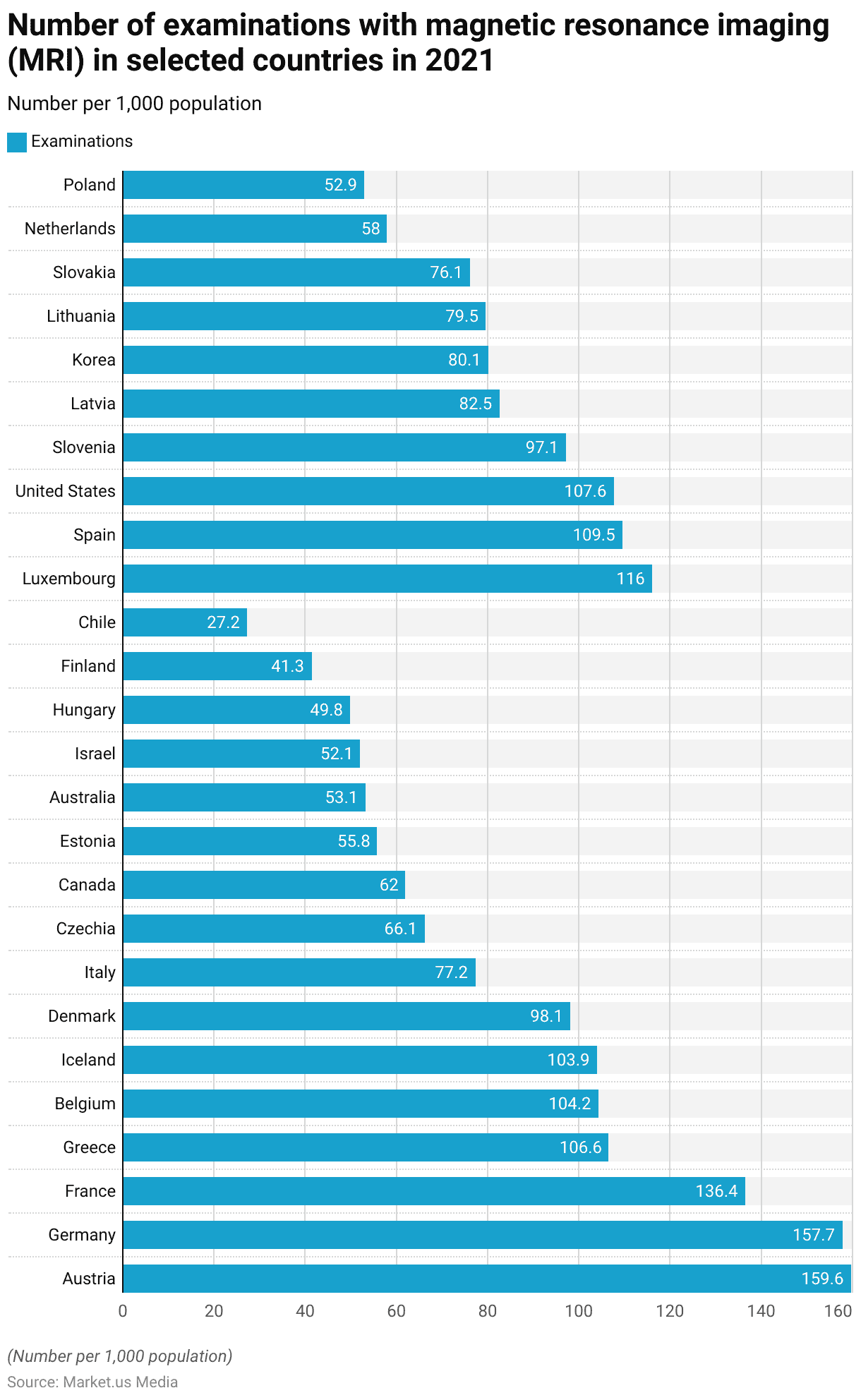
Number of Magnetic Resonance Imaging (MRI) Units – By Country
- As of 2021, the availability of magnetic resonance imaging (MRI) units per million population varied widely among selected countries.
- Japan had the highest density, with 57.39 MRI units per million people, followed by the United States with 37.99 units.
- South Korea and Germany had similar densities at 35.48 and 35.25 units, respectively.
- Greece and Italy followed with 33.78 and 33.25 units per million, while Finland reported 31.22 units.
- Austria and Spain recorded lower figures, with 26.57 and 20.35 MRI units per million people, respectively.
- In the mid-range, Iceland had 19.1 MRI units per million, and Latvia and Luxembourg reported 17.51 and 17.19 units, respectively.
- France had 17 units, while New Zealand and Estonia each recorded just over 16 units per million population.
- Ireland and Lithuania had densities of 15.5 and 15 units, respectively. While Australia and the Netherlands had close figures, each around 15 units per million.
- At the lower end of the scale, Slovenia had 13.28 MRI units per million. Followed by Chile with 12.27 and Czechia with 11.8.
- Poland and Turkey reported 11.44 and 11.41 units, while Belgium had 11.39 MRI units per million.
- Slovakia, Canada, and Denmark had MRI densities ranging between 10.05 and 9.22 units.
- Hungary and Israel reported lower densities of 5.15 and 5.02 MRI units per million, respectively.
- Mexico and Colombia had the lowest densities among the selected countries, with 2.92 and 0.24 MRI units per million population, respectively.
- These variations reflect disparities in healthcare infrastructure, investment, and access to advanced imaging technology across regions.
(Source: Statista)
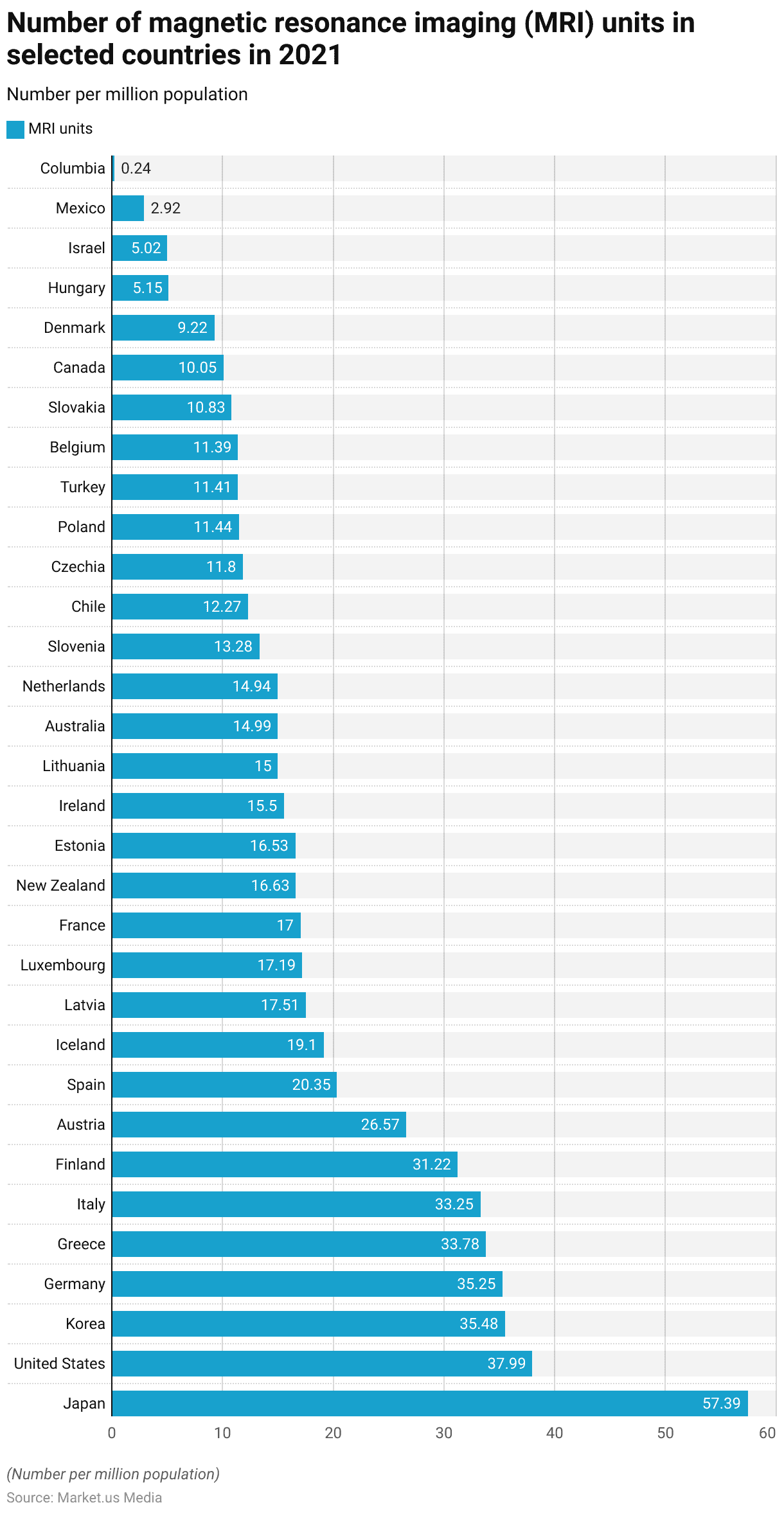
Medical Imaging Device Usage Statistics
Daily Hours of Usage of Medical Imaging Devices Statistics
- In 2019/2020, the daily usage hours of various medical imaging devices across Canadian health sites showed notable variation.
- CT scanners were the most frequently used, with 74 sites operating them for less than 8 hours per day, 80 sites for 8 to under 12 hours, 69 sites for 12 to under 18 hours, and 37 sites for over 18 hours daily.
- MRI machines, on the other hand, were primarily used between 12 to under 18 hours at 85 sites, while 26 sites operated them for under 8 hours, 39 sites for 8 to under 12 hours, and 23 sites for more than 18 hours.
- For PET-CT scanners, usage was more limited, with 12 sites operating them for less than 8 hours, 15 sites for 8 to under 12 hours, and only four sites for 12 to under 18 hours daily.
- PET-MRI had the least usage, with just one site operating it for under 8 hours daily.
- SPECT devices had 49 sites using them for less than 8 hours, 34 sites for 8 to under 12 hours, and a small number operating them for extended hours, with five sites using them for 12 to under 18 hours and only one site for more than 18 hours.
- SPECT-CT devices showed similar patterns, with 50 sites operating for under 8 hours, 43 sites for 8 to under 12 hours, and nine sites for 12 to under 18 hours, while no sites reported usage beyond 18 hours.
- This data indicates that CT and MRI devices are in higher demand and often used for extended periods. At the same time, PET-CT, PET-MRI, SPECT, and SPECT-CT are typically operated for shorter durations across Canadian healthcare facilities.
(Source: Statista)
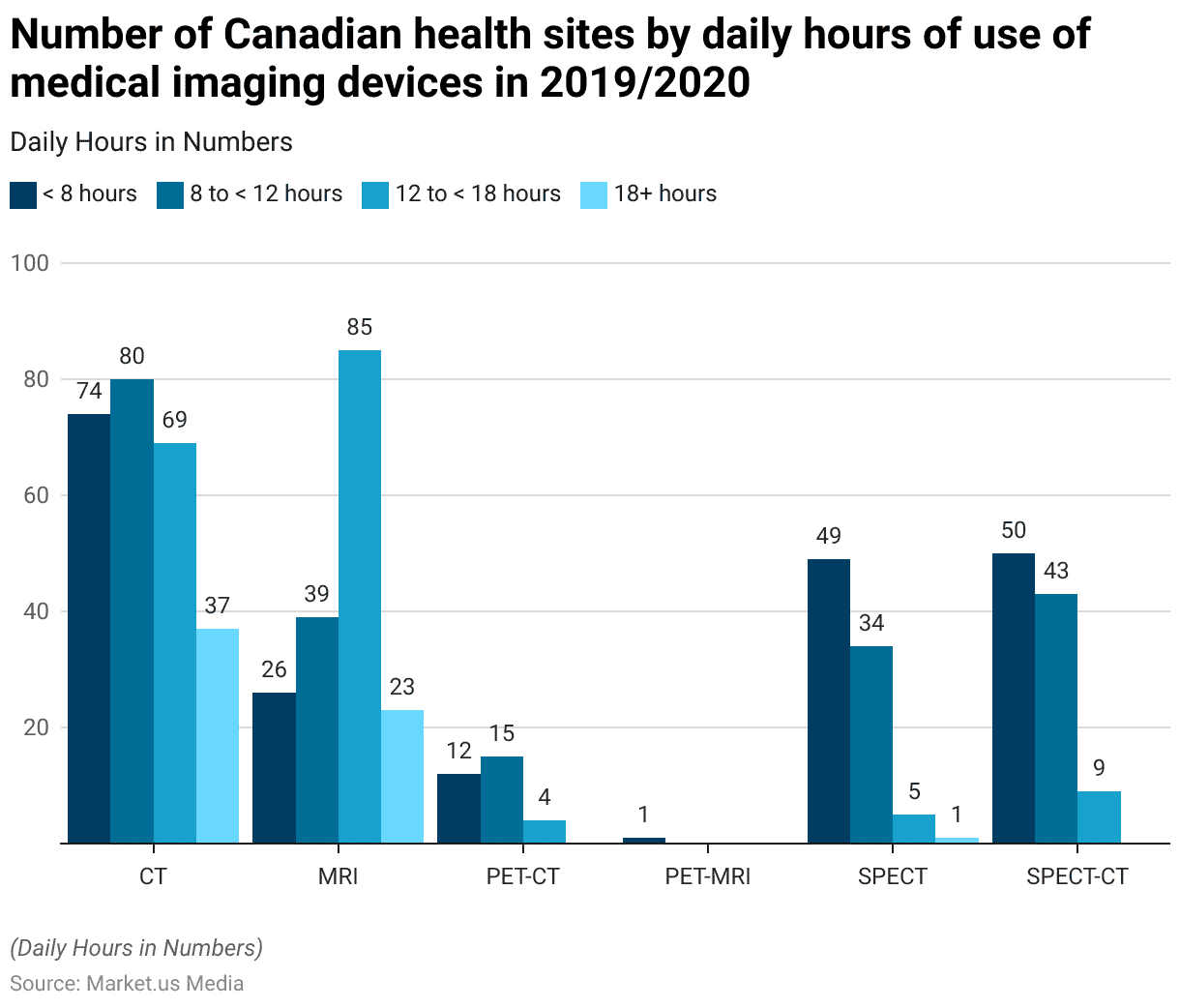
Radiology Scans Processed Per Day – By Institution Type
- As of 2023, the average number of radiology scans processed daily in India varies significantly by institution type.
- Large private hospitals lead with an average of 120 scans per day, followed by small and medium private hospitals, which process around 90 scans daily.
- National chain hospitals manage approximately 60 scans per day, while regional chain hospitals handle about 40 scans.
- Standalone labs have the lowest daily scan volume, averaging 30 scans.
- This distribution reflects the scale and capacity differences among healthcare providers. With larger institutions handle a higher patient volume and processing capacity than smaller facilities and independent labs.
(Source: Statista)

MRI Scans – By Facility Type
- In the United States, the total number of MRI scans conducted decreased from 39 million in 2016 to 36 million in 2017.
- This decline was primarily observed in non-hospital locations. Where MRI scans dropped from 22.5 million in 2016 to 18 million in 2017.
- Conversely, hospital-based MRI scans experienced a slight increase, rising from 16.2 million in 2016 to 17.7 million in 2017.
- This shift suggests a trend toward hospital-based MRI utilization, with fewer scans being conducted in non-hospital facilities during this period.
(Source: Statista)
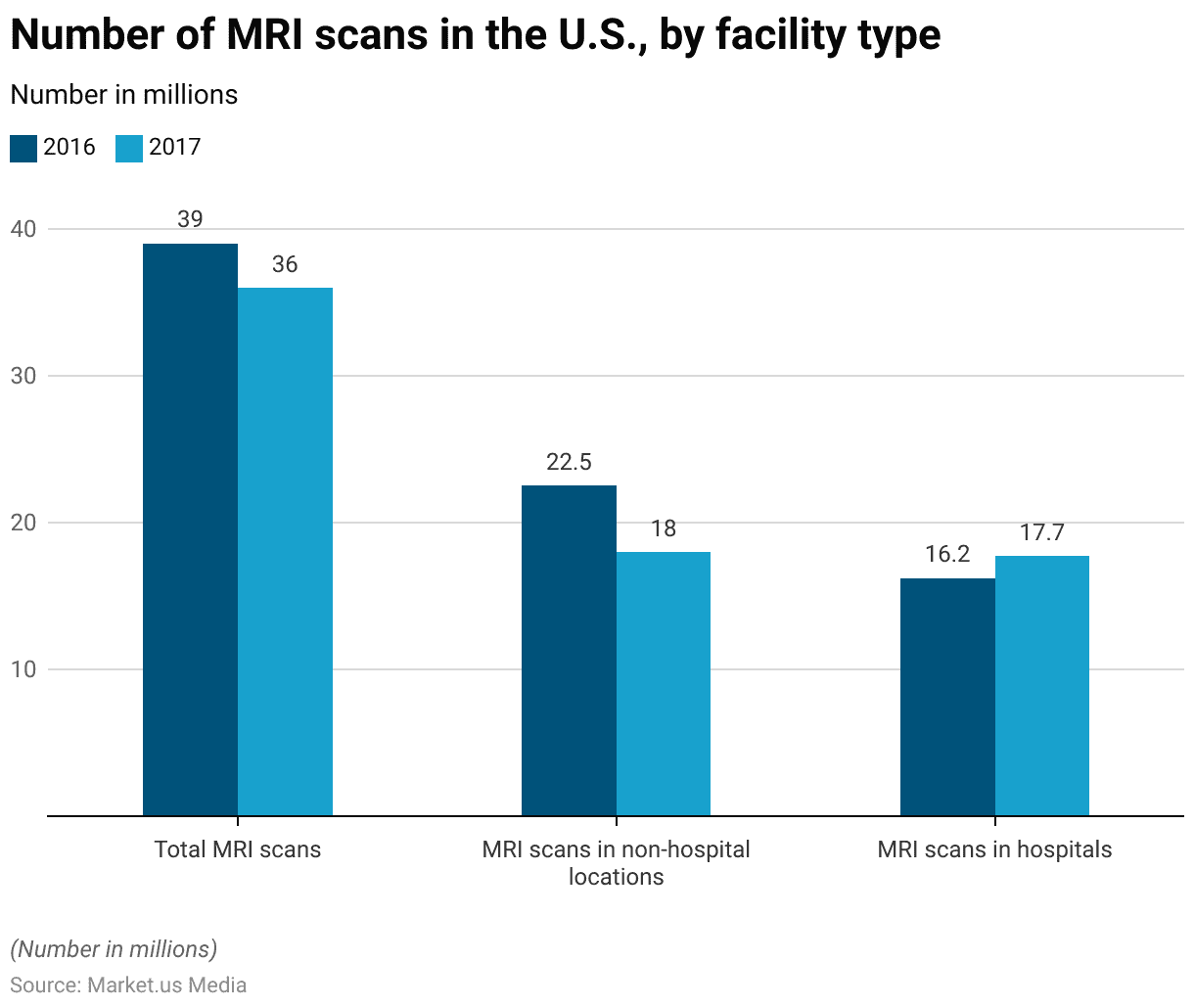
Computed Tomography (CT) Scan Examinations
- The number of computed tomography (CT) scan examinations conducted in France exhibited an overall upward trend from 2013 to 2022.
- In 2013, approximately 12,115,620 CT scans were performed, with a slight decline in 2014 to 11,896,610 scans.
- However, this was followed by a steady increase, with 12,557,790 scans in 2015 and 12,945,750 in 2016.
- The growth continued modestly, reaching 12,686,590 scans in 2017 and further increasing to 13,106,630 in 2018.
- By 2019, the number of CT scans rose to 13,384,680, although there was a minor dip in 2020, with 13,348,470 examinations conducted, possibly reflecting healthcare disruptions.
- Post-2020, the demand for CT scans surged, with 14,757,060 scans recorded in 2021 and a further increase to 15,193,050 in 2022.
- This upward trend underscores the growing reliance on CT imaging in France, driven by advancements in diagnostic capabilities and an expanding focus on healthcare diagnostics.
(Source: Statista)

PET Examinations
- The number of PET (Positron Emission Tomography) examinations in the United States saw fluctuations from 2010 to 2020, with a notable upward trend in recent years.
- In 2010, approximately 875,900 PET exams were conducted, which increased to 944,600 in 2011.
- The following years showed slight variations, with PET scans totaling 893,500 in 2012, 842,400 in 2013, and 856,400 in 2014.
- A slight decline occurred in 2015, with the number dropping to 830,100.
- From 2016 onward, PET exams began to increase steadily, reaching 876,700 in 2016 and 933,000 in 2017, surpassing the one million mark in 2018 with 1,058,000 scans.
- A significant surge occurred in 2019, with the number of PET exams jumping to 2,200,800, followed by a further increase to 2,220,300 in 2020.
- This substantial rise in recent years highlights the growing demand and utilization of PET imaging in the U.S., driven by advancements in diagnostic applications and an expanding focus on precision in healthcare.
(Source: Statista)
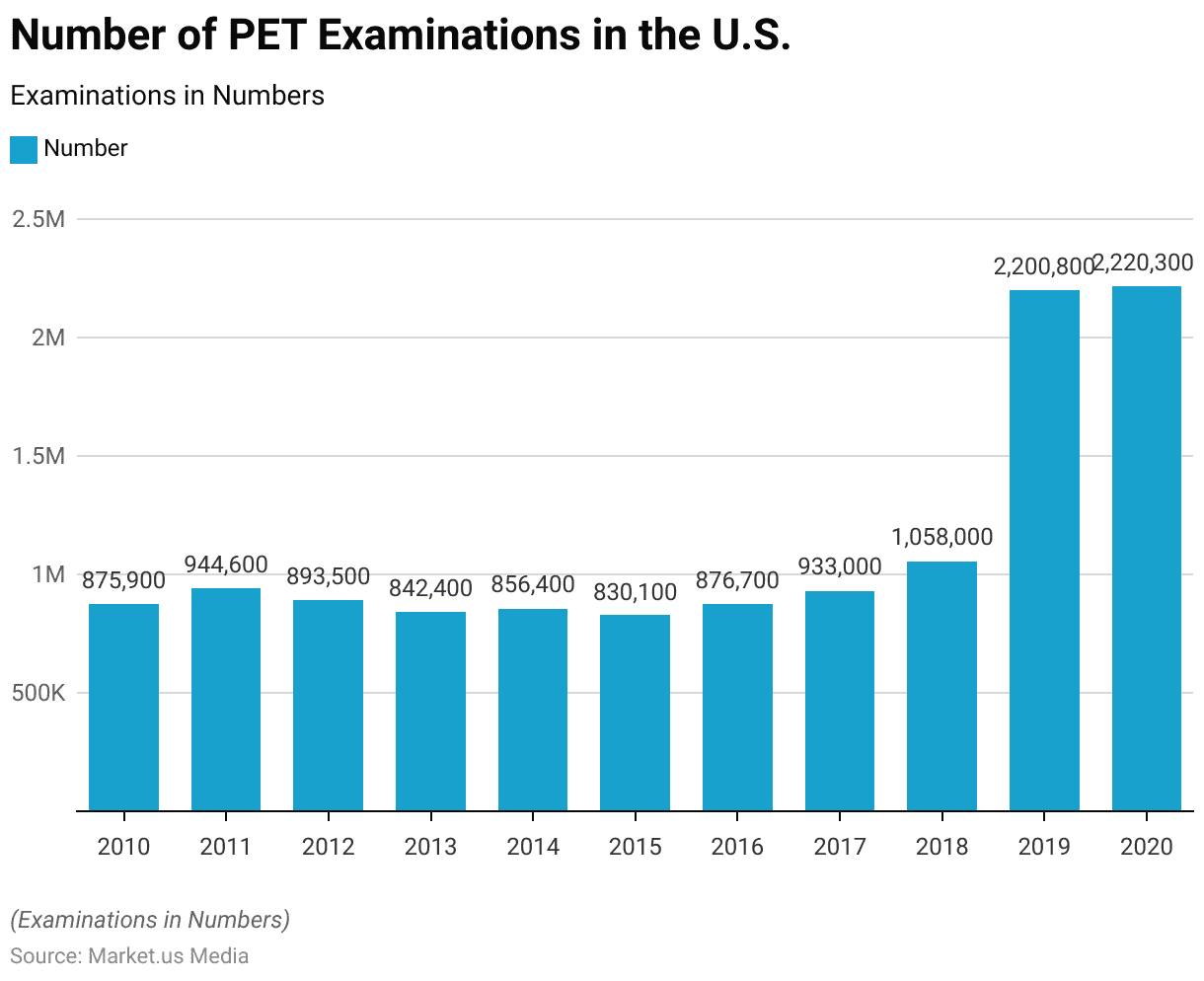
Medical Imaging Cost Statistics
Most Common Radiology Procedures – By Total Charges
- In 2018, the most common radiology procedures performed at imaging centers in the United States, ranked by total charges, showcased a variety of diagnostic imaging needs.
- Screening mammography for bilateral detection with computer-aided detection led the list with total charges amounting to USD 718.5 million.
- An MRI of the lumbar spine followed this without dye, which incurred USD 686.8 million in charges.
- The MRI of the lower extremity joint without dye also ranked high, with total charges reaching USD 627.6 million.
- Additional high-cost procedures included an MRI of the brain stem with and without dye (USD 524.9 million) and a CT of the abdomen and pelvis with contrast, totaling USD 419.3 million in charges.
- MRI of the upper extremity joint without dye accounted for USD 368.4 million, while PET imaging combined with CT from skull to thigh generated USD 364.9 million in charges.
- MRI of the neck spine without dye accumulated charges of USD 362.2 million, while MRI of the brain stem without dye and CT of the abdomen and pelvis without contrast contributed USD 298.9 million and USD 229.8 million, respectively.
- These figures reflect the high demand and associated costs for advanced imaging procedures across various anatomical regions in the U.S.
(Source: Statista)

Health Insurance Expenditure by Medical Imaging Examination – By Family of Acts Statistics
- In 2014, the average health insurance expenditure per medical imaging examination in France varied significantly across different types of imaging.
- Scintigraphy incurred the highest average cost at €317.87 per examination, followed by MRI scans at €188.36.
- Other imaging modalities averaged €164.89 per examination while scanning procedures had an average cost of €118.57.
- The overall average expenditure for imaging procedures was €56.98.
- Ultrasound examinations were relatively cost-effective, averaging €47.02, and radiography incurred the lowest average expenditure at €30.24.
- These figures illustrate the range of costs associated with different imaging techniques, reflecting the varying levels of complexity and technology involved in each type of examination.
(Source: Statista)
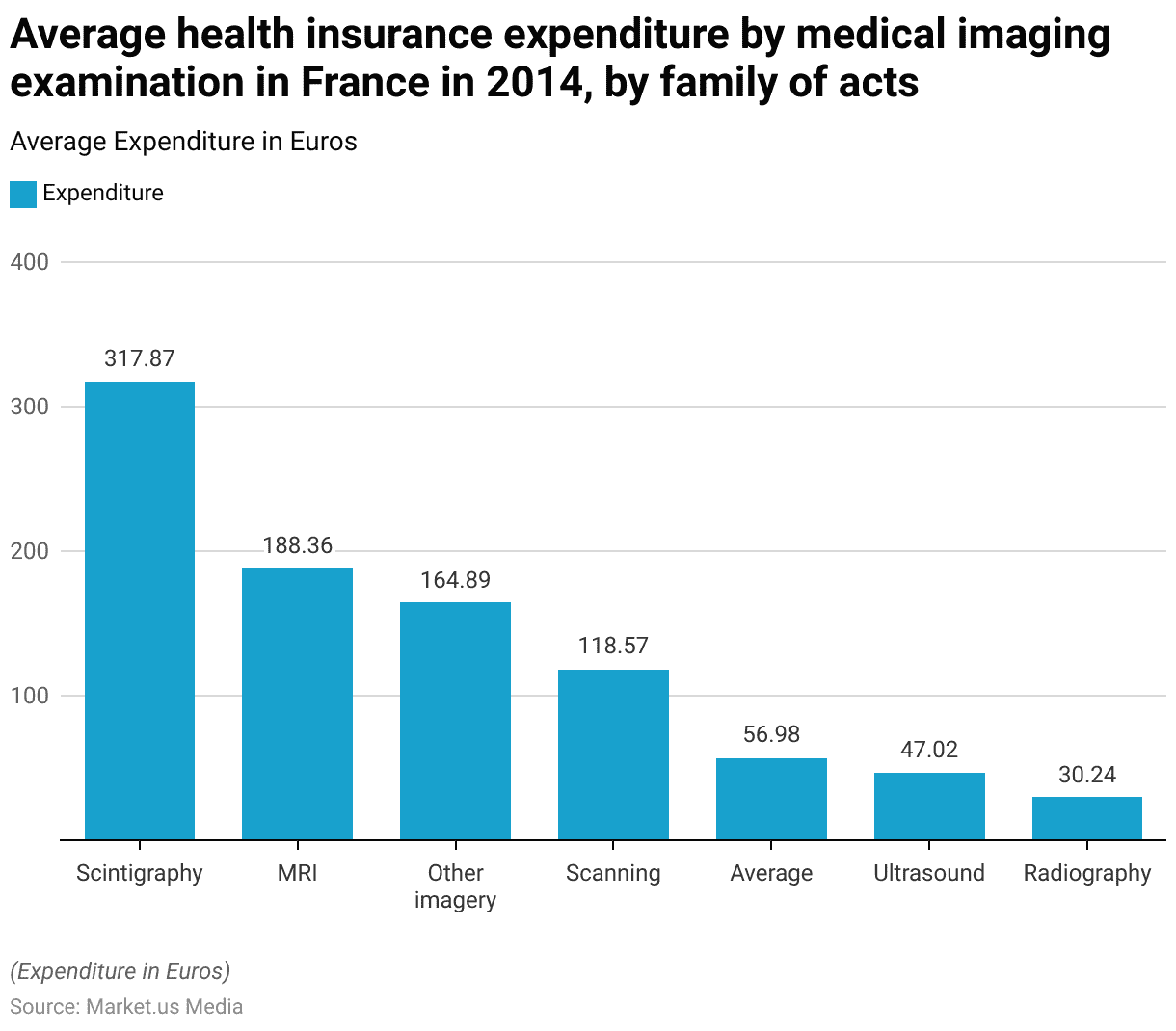
CT Scan Lab Work Cost Savings Through Telehealth Use
- In 2017, the estimated annual cost savings for CT scan labs through the use of telehealth varied widely across U.S. states, reflecting the differences in healthcare infrastructure and telehealth adoption.
- California reported the highest savings per facility at USD 251,846, followed by Texas with savings of USD 153,648 and Florida with USD 116,609.
- New York also saw substantial savings, amounting to USD 130,414 per facility.
- Several other states reported notable savings, including Illinois (USD 73,590), Pennsylvania (USD 71,666), New Jersey (USD 58,464), and Georgia (USD 54,169).
- Michigan and North Carolina followed closely, with savings of USD 53,333 and USD 53,116, respectively.
- Savings in Virginia, Massachusetts, and Washington ranged between USD 41,646 and USD 49,268 per facility.
- In the mid-range, Arizona, Maryland, Colorado, and Indiana reported savings between USD 30,000 and USD 40,000, with savings per facility in these states indicating moderate adoption and benefit from telehealth.
- States such as Alabama, Louisiana, Oklahoma, and Oregon achieved savings ranging from USD 20,000 to USD 25,000.
- Some states experienced lower estimated savings, such as Hawaii (USD 9,525), Rhode Island (USD 5,952), and Montana (USD 5,606).
- At the same time, Wyoming, Vermont, and North Dakota saw the lowest savings, ranging from USD 3,215 to USD 3,959 per facility.
- This distribution of savings highlights the varying impact of telehealth across the U.S., with states that have higher healthcare demands and advanced telehealth networks achieving the most significant cost reductions in CT scan lab operations.
(Source: Statista)
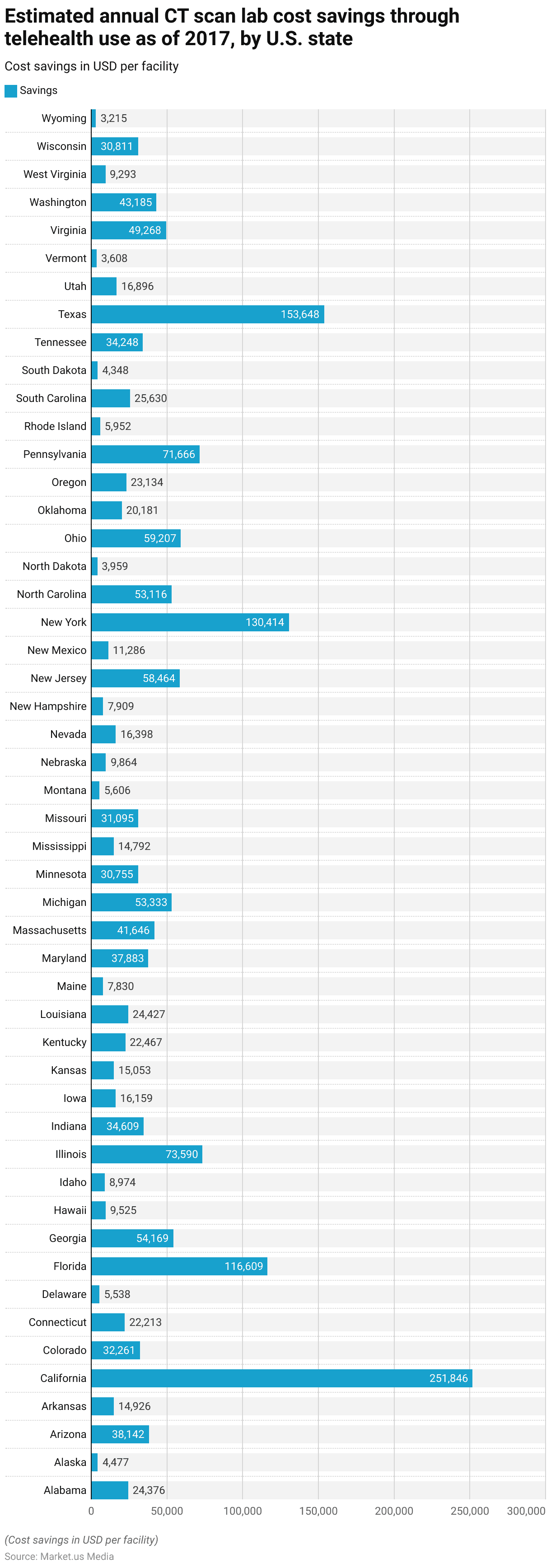
Waiting Time for Medical Scans
Waiting Weeks to Receive a CT Scan in Canada
- From 2015 to 2022, the waiting time for patients to receive a CT scan in Canada showed a general increase, reflecting growing demand and possible constraints in healthcare resources.
- In 2015, the average wait time was 4 weeks, which decreased slightly to 3.7 weeks in 2016.
- However, by 2017, the wait time rose to 4.1 weeks, followed by a gradual increase to 4.3 weeks in 2018 and 4.8 weeks in 2019.
- In 2020, the wait time saw a significant increase to 5.4 weeks. Possibly due to healthcare disruptions and capacity constraints during the COVID-19 pandemic.
- Although there was a slight improvement in 2021, with the wait time dropping to 5.2 weeks, it returned to 5.4 weeks in 2022.
- This trend highlights ongoing challenges within the Canadian healthcare system in meeting the rising demand for diagnostic imaging services, particularly CT scans.
(Source: Statista)
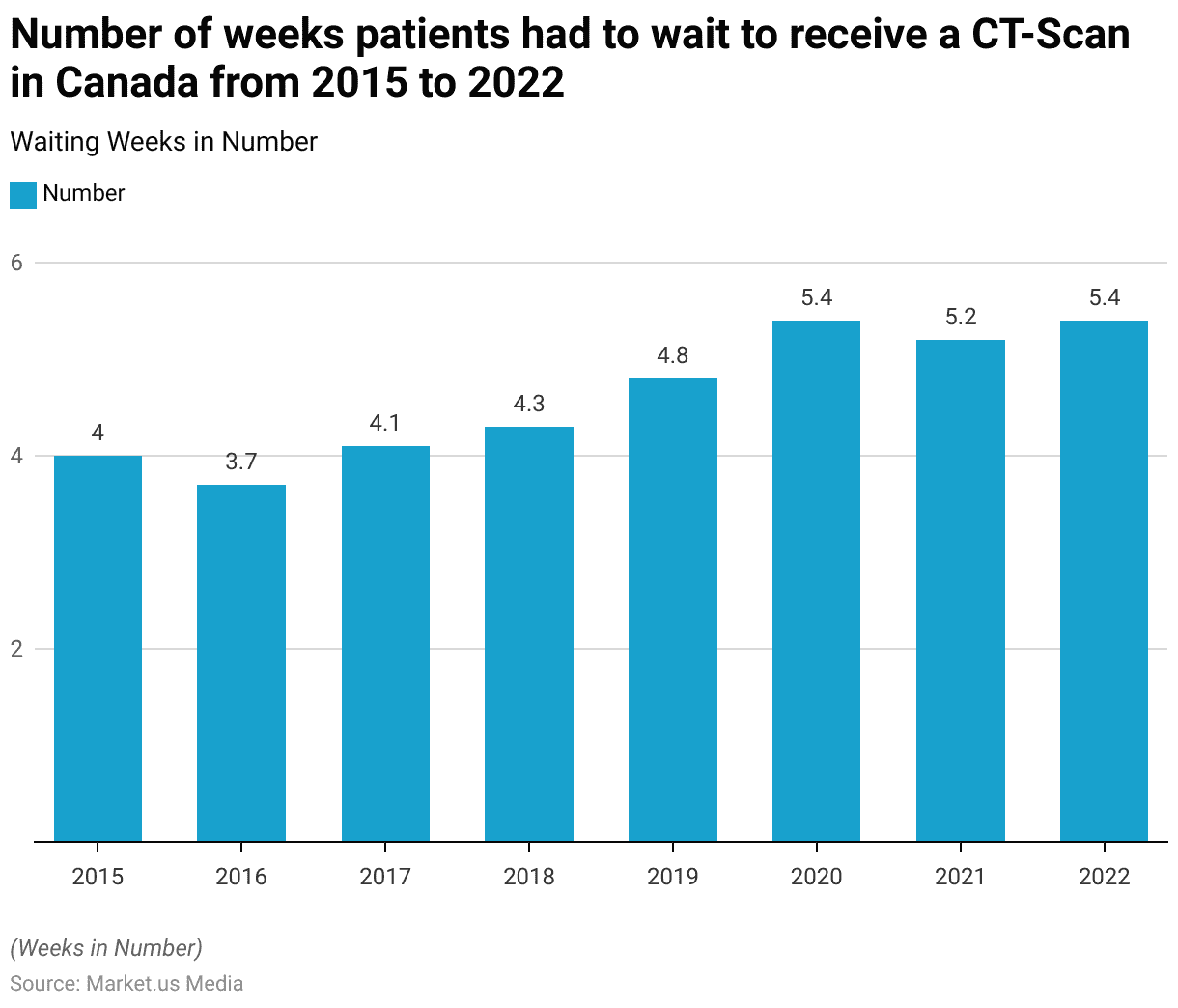
Average Waiting Time for MRI Scans in the Netherlands
- From 2010 to 2022, the average waiting time for MRI scans in the Netherlands experienced fluctuations, with a general upward trend toward the end of the period.
- In 2010, the waiting time was 2.82 weeks, which gradually decreased to 2.65 weeks in 2011 and 2.66 weeks in 2012.
- By 2013, the wait time had further reduced to 2.33 weeks, followed by a slight increase to 2.42 weeks in 2014.
- The shortest average wait time was recorded in 2015, at 2.22 weeks.
- However, beginning in 2016, the waiting time started to rise again, reaching 2.61 weeks, and by 2022, the average waiting period had increased significantly to 3.16 weeks.
- This recent increase may reflect the growing demand for MRI services and potential challenges in meeting healthcare needs within the Dutch healthcare system.
(Source: Statista)
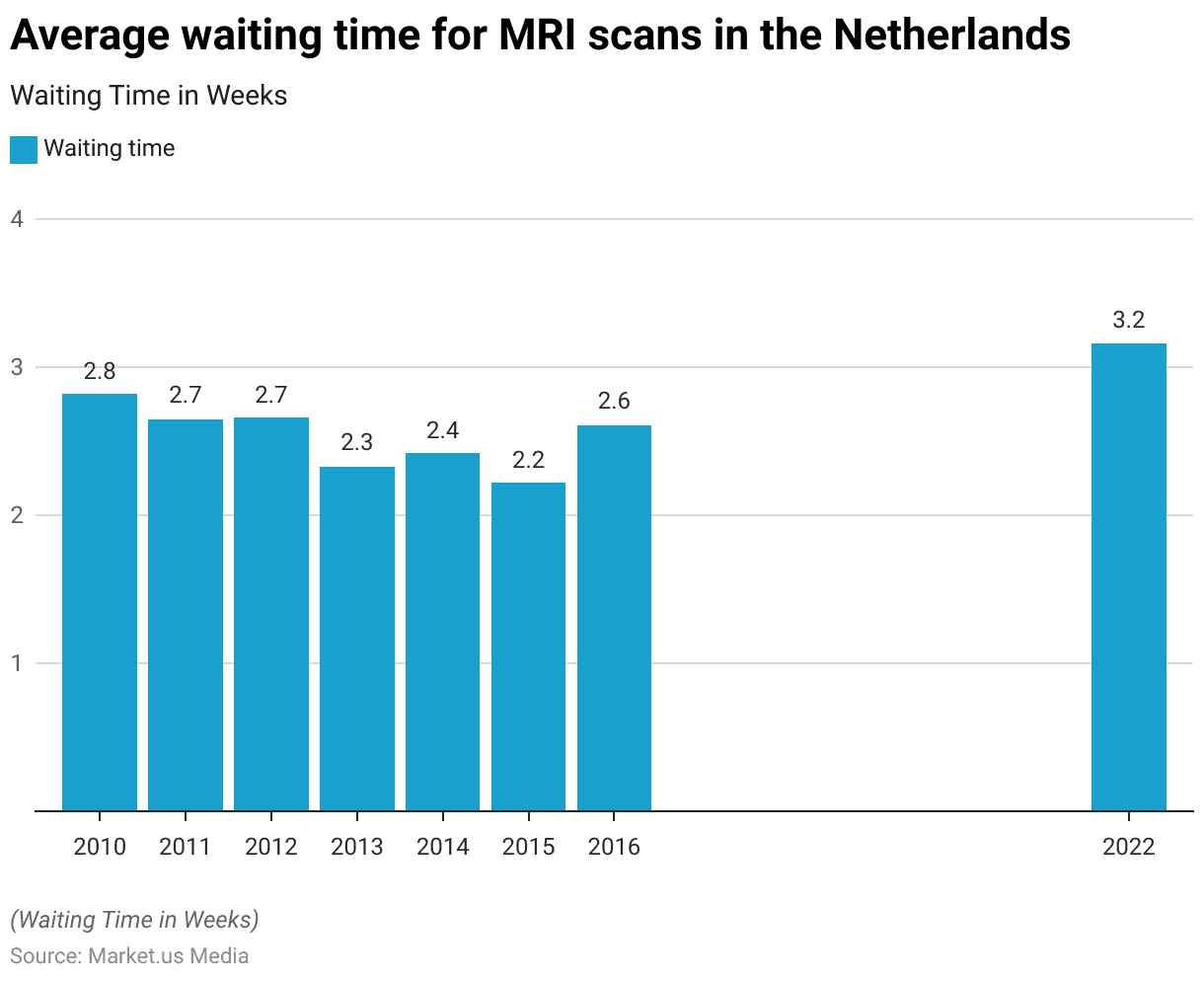
Waiting Period for X-ray or Scan Results in the United Kingdom (UK)
- In the United Kingdom, during 2015/16, the waiting times for receiving X-ray or scan results varied widely.
- About 12.8% of respondents reported receiving results within minutes, while 8.8% obtained results within hours.
- A small portion, 8.3%, received results within 0-3 days, and 14.6% had a waiting period of 3-7 days.
- A further 9.6% waited over seven days, while 14.9% of respondents received their results within 1-2 weeks.
- Longer wait times were also common, with 9.1% waiting 2-3 weeks and 7.2% waiting 3-4 weeks.
- Approximately 8.7% experienced a wait of 1-3 months. Extended wait times were reported less frequently; 2.9% waited 3-6 months, 0.6% waited 6-9 months, and 0.3% waited 9-12 months.
- A notable 2.1% of respondents had to wait more than 12 months for their results.
- This distribution indicates significant variation in access to timely imaging results, with a considerable portion of patients experiencing extended delays.
(Source: Statista)

Key Investments
Value of Medical Technology Venture Capital Investments Worldwide
- From 2008 to 2021, global venture capital investments in medical technology experienced significant fluctuations, indicating varying levels of investor confidence and market dynamics.
- In 2008, investment value stood at USD 3.2 billion, gradually increasing to USD 3.5 billion in 2009 and further to USD 4.4 billion in 2010.
- The upward trend continued with a slight increase to USD 4.5 billion in 2011.
- However, in 2012, investments declined to USD 3.7 billion, rebounding to USD 4.2 billion in 2013 and reaching USD 5 billion in 2014.
- In 2015 and 2016, investments stabilized at USD 4.5 billion, but the sector saw a notable increase in 2017, with investments surging to USD 7.2 billion.
- This momentum continued, albeit with some fluctuations, as investments decreased to USD 6.5 billion in 2018 and USD 6.1 billion in 2019.
- In 2020, venture capital funding rose again to USD 7.3 billion, driven partly by the heightened focus on healthcare innovation during the COVID-19 pandemic.
- By 2021, the investment value peaked at USD 10 billion, reflecting strong investor interest in medical technology and its potential for growth and innovation.
- This trend underscores the increasing role of venture capital in advancing healthcare technologies globally.
(Source: Statista)

Venture Investment Value in the Medical Technology Industry in the U.S.
- From 2019 to 2024, the quarterly value of venture investments in the U.S. medical technology industry displayed notable fluctuations.
- In 2019, investment values were relatively stable, starting at USD 2.5 billion in Q1, rising to USD 3.7 billion in Q2, peaking at USD 4.4 billion in Q3, and closing at USD 3.5 billion in Q4.
- In 2020, there was a marked increase, beginning with USD 5.1 billion in Q1, followed by USD 4.4 billion in Q2, and reaching USD 6.8 billion and USD 6.3 billion in Q3 and Q4, respectively, as the COVID-19 pandemic accelerated interest in healthcare technologies.
- The year 2021 saw a sharp surge in venture investments, with Q1 starting at USD 9.1 billion and escalating to a high of USD 13.9 billion in Q2.
- The momentum continued in Q3 and Q4 with investments of USD 9.5 billion and USD 10.5 billion, respectively.
- In 2022, investment levels began to decline, with USD 9.3 billion in Q1 and dropping to USD 7.6 billion in Q2, USD 5.6 billion in Q3, and a further decline to USD 2.8 billion by Q4.
- In 2023, the investment levels remained subdued, starting at USD 3.8 billion in Q1, reaching USD 5 billion in Q2, then falling to USD 3.6 billion and USD 3.4 billion in Q3 and Q4.
- By 2024, the available data shows investments of USD 5.4 billion in Q3 and a slight decrease to USD 4.3 billion in Q4.
- This trend reflects varying investor confidence and shifting focus within the medical technology sector over these years.
(Source: Statista)
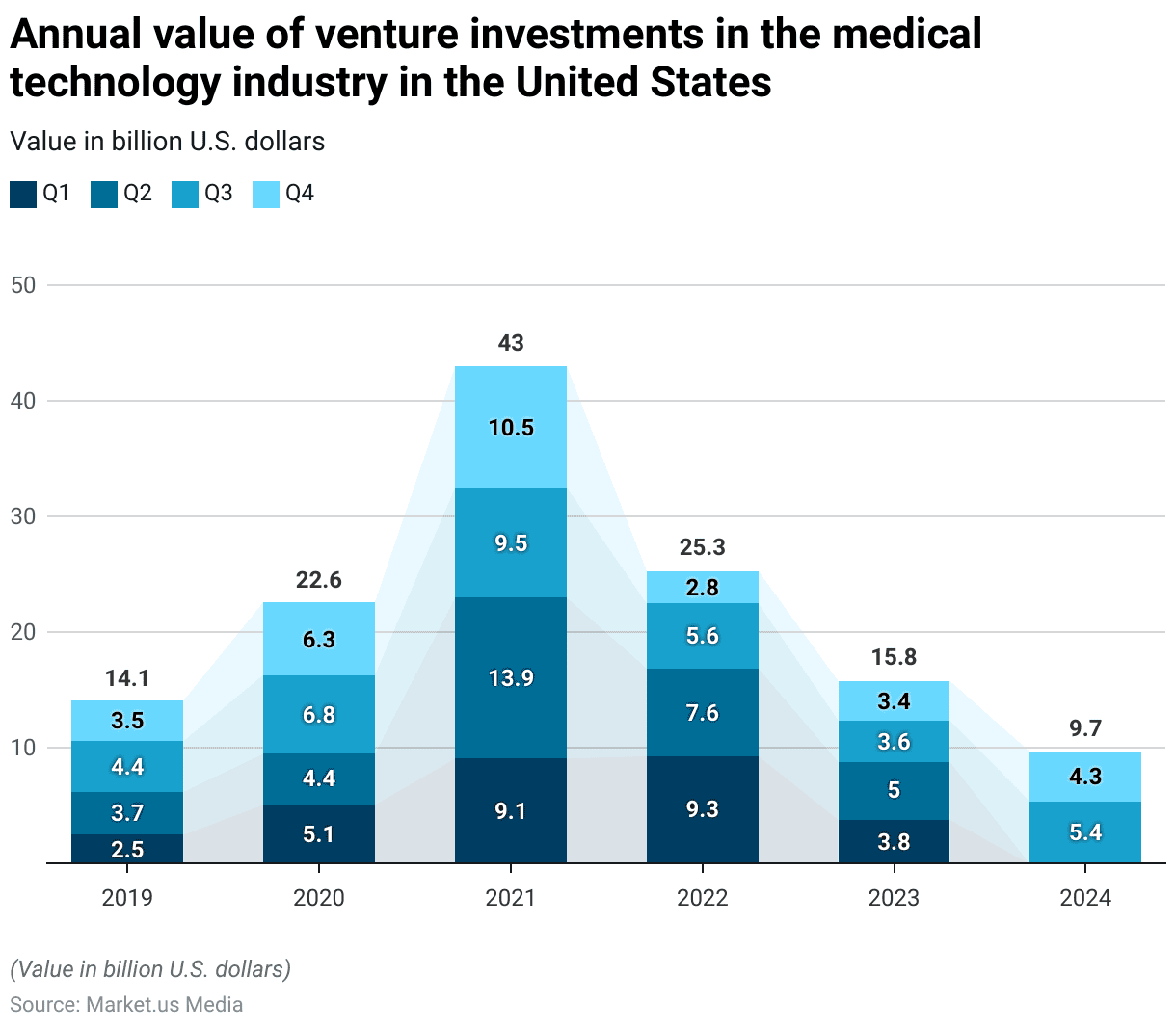
Regulations for Medical Imaging Devices
- Regulations for medical imaging devices vary significantly across different countries, reflecting localized approaches to healthcare regulation and patient safety.
- In the United States, the Food and Drug Administration (FDA) classifies medical devices into three categories—Class I, II, and III—based on risk, with increasing levels of regulatory control for each class.
- Devices like MRI machines and CT scanners often fall into the higher-risk categories, requiring rigorous premarket approval processes.
- In Europe, the European Medical Device Regulation (MDR) applies stringent standards, emphasizing clinical evaluation and post-market surveillance to ensure device safety and efficacy.
- Countries in the Asia-Pacific region, such as Japan and Singapore, align closely with international standards set by bodies like the International Medical Device Regulators Forum, aiming for harmonization in regulatory practices to facilitate market access and ensure safety.
- Additionally, novel technologies like AI in medical imaging are prompting regulators worldwide to update and refine guidelines to address these advanced capabilities and their implications on diagnostic accuracy and patient management.
(Sources: WHO, FDA)
Recent Developments
Acquisitions and Mergers:
- Siemens Healthineers acquires Varian Medical Systems: In 2023, Siemens Healthineers completed its acquisition of Varian Medical Systems. A leader in cancer treatment and medical imaging, for $16.4 billion. This merger aims to enhance Siemens’ offerings in advanced imaging technologies for oncology, combining diagnostic imaging with therapeutic capabilities.
- Philips merges with BioTelemetry: In early 2024, Philips announced a merger with BioTelemetry. A provider of remote cardiac monitoring solutions, for $2.8 billion. This merger is expected to strengthen Philips’ capabilities in telehealth and imaging, particularly for cardiovascular applications.
New Product Launches:
- GE Healthcare launches Revolution Ascend CT scanner: In mid-2023, GE Healthcare introduced the Revolution Ascend. A new CT scanner that utilizes advanced AI algorithms to improve image quality and reduce scan times by 30%. This product targets hospitals and diagnostic centers aiming to enhance patient throughput.
- Canon Medical Systems unveils the Aquilion ONE Genesis Edition: In late 2023, Canon Medical Systems launched the Aquilion ONE Genesis Edition. An advanced CT imaging system designed for high-resolution imaging and faster diagnostics. This system is expected to reduce radiation exposure by 40% while providing high-quality images for accurate diagnoses.
Funding:
- Zebra Medical Vision raises $50 million for AI-based imaging solutions: In 2023, Zebra Medical Vision, a company specializing in AI for medical imaging analysis. Raised $50 million to expand its product offerings. The funding will be used to enhance its AI algorithms and improve the accuracy of imaging diagnostics.
- Imbio secures $20 million to develop imaging software: In early 2024, Imbio, a developer of imaging analysis software. Raised $20 million in funding to advance its machine-learning technologies for lung imaging. This funding will support the expansion of its software solutions for early disease detection.
Technological Advancements:
- AI integration in medical imaging: By 2025, it is projected that 50% of medical imaging systems will incorporate AI-driven analysis tools. Improving diagnostic accuracy and efficiency in detecting conditions such as tumors and fractures.
- 3D imaging technology growth: The adoption of 3D imaging technology in medical diagnostics is increasing. By 2026. 35% of medical imaging procedures are expected to utilize 3D imaging techniques, enhancing visualization and improving surgical planning.
Conclusion
Medical Imaging Statistics – The medical imaging industry is growing steadily due to technological advancements, increased healthcare needs, and a focus on early diagnostics.
Key imaging modalities like MRI, CT, ultrasound, and PET are in high demand. Driven by the prevalence of chronic diseases and an aging population.
The integration of AI and analytics software is transforming diagnostics and improving workflow efficiency, with significant growth in North America, Europe, and Asia-Pacific.
While venture investments drive innovation, challenges remain around accessibility, costs, and infrastructure disparities.
Overall, the industry is set to enhance diagnostic accuracy and patient outcomes. Although addressing these challenges will be essential to ensure widespread benefit.
FAQs
Medical imaging refers to techniques and processes used to create visual representations of the inside of the body for clinical analysis, diagnosis, and treatment planning. Common imaging types include X-rays, MRI, CT scans, ultrasound, and PET scans.
Medical imaging allows healthcare providers to diagnose diseases, monitor treatment progress, and guide procedures. It plays a critical role in early detection, which can improve treatment outcomes and save lives.
Most medical imaging procedures are safe, though some involve radiation exposure, like X-rays and CT scans. Radiation exposure is kept to the minimum necessary for diagnosis, and non-radiation options like MRI and ultrasound are available for certain conditions.
AI in medical imaging refers to using artificial intelligence to assist in analyzing imaging data, improving diagnostic accuracy, and optimizing workflow. AI can help detect abnormalities, prioritize urgent cases, and provide insights that aid in faster and more accurate diagnoses.
Medical imaging is used to diagnose conditions, assess injuries, guide surgeries, monitor disease progression, and evaluate treatment effectiveness across a range of specialties. Including oncology, cardiology, neurology, and orthopedics.
Discuss your needs with our analyst
Please share your requirements with more details so our analyst can check if they can solve your problem(s)



